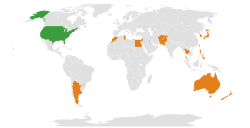South Korea
Coordinates: 36°N 128°E / 36°N 128°E
Republic of Korea
|
||||||
|---|---|---|---|---|---|---|
|
||||||
| Motto: "홍익인간" (Korean) (de facto) "Benefit broadly in the human world/Devotion to the Welfare of Humanity"[1] |
||||||
| Anthem: Aegukga "애국가" (Korean) (de facto) "Patriotic Song" |
||||||
Government Emblem Government Emblem of South Korea |
||||||
.svg.png) Area controlled by the Republic of Korea shown in green
|
||||||
| Capital and largest city | Seoul 37°33′N 126°58′E / 37.550°N 126.967°E | |||||
| Official languages | Korean | |||||
| Official scripts | Hangul | |||||
| Ethnic groups | no official statistics[2][3] | |||||
| Demonym | ||||||
| Government | Unitary presidential constitutional republic |
|||||
| • | President | Park Geun-hye | ||||
| • | Prime Minister | Hwang Kyo-ahn | ||||
| • | Speaker of the National Assembly | Chung Sye-kyun | ||||
| • | Chief Justice | Yang Sung-tae | ||||
| Legislature | National Assembly | |||||
| Formation | ||||||
| • | First Kingdom | c. 7th century BC | ||||
| • | Three Kingdoms | 18 BC | ||||
| • | North-South Kingdoms | 698 | ||||
| • | Unitary dynasties | 918 | ||||
| • | Japan-Korea Treaty | August 29, 1910 | ||||
| • | Gwangbokjeol | August 15, 1945 | ||||
| • | First Republic | August 15, 1948 | ||||
| • | Current constitution | October 1987 | ||||
| Area | ||||||
| • | Total | 100,210 km2 38,691 sq mi |
||||
| • | Water (%) | 0.3 (301 km2 / 116 mi2) | ||||
| Population | ||||||
| • | 2016 estimate | 50,801,405[4][5] (27th) | ||||
| • | Density | 507/km2 (23rd) 1,313.1/sq mi |
||||
| GDP (PPP) | 2016 estimate | |||||
| • | Total | $1.929 trillion[6] (13th) | ||||
| • | Per capita | $37,948[6] (28th) | ||||
| GDP (nominal) | 2016 estimate | |||||
| • | Total | $1.404 trillion[6] (11th) | ||||
| • | Per capita | $27,633[6] (27th) | ||||
| Gini (2013) | 30.2[7] medium |
|||||
| HDI (2014) | very high · 17th |
|||||
| Currency | South Korean won (₩) (KRW) |
|||||
| Time zone | Korea Standard Time (UTC+9) | |||||
| Date format |
|
|||||
| Drives on the | right | |||||
| Calling code | +82 | |||||
| ISO 3166 code | KR | |||||
| Internet TLD | ||||||
| South Korea | |
| Hangul | 대한민국 |
|---|---|
| Hanja | 大韓民國 |
| Revised Romanization | Daehan Min-guk |
| McCune–Reischauer | Taehan Min’guk |
South Korea (![]() listen), officially the Republic of Korea (ROK;
listen), officially the Republic of Korea (ROK; ![]() listen), is a sovereign state in East Asia, constituting the southern part of the Korean Peninsula.[9]
listen), is a sovereign state in East Asia, constituting the southern part of the Korean Peninsula.[9]
Highly urbanized at 92%,[10] South Koreans lead a distinctive urban lifestyle; half of them live in high-rises[11] concentrated in the Seoul Capital Area with 25 million residents[12] and the world's sixth leading global city[13] with the fourth largest economy[14] and seventh most sustainable city in the world.[15]
The earliest Korean pottery dates to 8000 BC,[16] with three kingdoms flourishing in the 1st century BC. The name Korea is derived from one of them, Goguryeo, also known as Koryŏ, which was a powerful empire and one of the great powers in East Asia,[17][18][19][20] ruling Northeast China, parts of Russia[21] and Inner Mongolia,[22] and more than two-thirds of the Korean Peninsula under Gwanggaeto the Great.[23] Since their unification into Later Silla and Balhae in the 7th century, Korea enjoyed over a millennium of relative tranquility under long lasting dynasties,[24] with innovations like Hangul, the unique alphabet created by Sejong the Great in 1446, enabling anyone to easily learn to read and write.[25] Its rich and vibrant culture left 17 UNESCO Intangible Cultural Heritages of Humanity, the third largest in the world, along with 12 World Heritage Sites. Annexed by Imperial Japan in 1910 due to its strategic and central location, Korea was divided into North and South after its surrender in 1945. A North Korean invasion led to the Korean War (1950–53). Peace has since mostly continued with the two agreeing to work peacefully for reunification and the South solidifying peace as a regional power with the world's 10th largest defence budget.
South Korea's tiger economy soared at an annual average of 10% for over 30 years[26] in a period of rapid transformation called the Miracle on the Han River. A long legacy of openness and focus in innovation made it successful.[27] Today, it is the world's fifth largest exporter and seventh largest importer with the G20's largest budget surplus[28] and highest credit rating of any country in East Asia.[29] It has free trade agreements with 75% of the world economy and is the only G20 nation trading freely with China, the US and EU simultaneously.[30] In 1987, it became a multi-party democracy with universal suffrage and is today Asia's most advanced democracy with high government transparency, universal healthcare and freedom of religion. High civil liberties led to the rise of a globally influential pop culture[31] such as K-pop and K-drama, a phenomenon called the Korean Wave, known for its distinctive fashionable and trendy style.[32] Home of the UN Green Climate Fund and GGGI, South Korea is a leader in low carbon green growth,[33] committed to helping developing countries as a major DAC and Paris Club contributor. It is the OECD's most welcoming country by visa-free entry to foreigners[34] and rated highly in peaceful tolerance and inclusion of minorities.[35]
South Korea is East Asia's most developed country in the Human Development Index. It has the world's eighth highest median household income, the highest in Asia, and its singles in particular earn more than all G7 nations. Globally, it ranks highly in personal safety,[36] education, job security, ease of doing business and healthcare quality, with the world's third highest health adjusted life expectancy and fourth most efficient healthcare system.[37] It leads the OECD in graduates in science and engineering[38] and is ranked third in the Youth Wellbeing Index.[39] Home of Samsung, the world's leading smartphone and TV maker,[40][41] LG and Hyundai-Kia, South Korea was named the world's most innovative country in the Bloomberg Innovation Index,[42] ranking first in business R&D intensity and patents filed per GDP. Due to its development and capabilities, political scientists have ranked it among Asia-Pacific's middle powers.[43] It has the world's fastest Internet speed and highest smartphone ownership, ranking first in ICT Development, e-Government[44] and 4G LTE coverage. In 2005, it became the world's first country to fully transition to high-speed Internet and start the world's first mobile TV broadcast with 97% of cellphones already having Internet access.[45]
Etymology
The name Korea derives from Goryeo (also spelled as Koryŏ), the successor state of Goguryeo (Koguryŏ),[46][47][48][49] and the first Korean dynasty visited by Persian merchants, who called it "Korea".[50] The name Goryeo (a shortened form of Goguryeo) originally referred to the ancient kingdom of Goguryeo, which referred to itself, and was widely referred to, as "Goryeo" since the 5th century.[51] The modern spelling, "Korea", first appeared in the late 17th century in the travel writings of the Dutch East India Company's Hendrick Hamel.[51] Despite the coexistence of the spellings Corea and Korea in 19th century publications, some Koreans believe that Imperial Japan, around the time of the Japanese occupation, intentionally standardised the spelling on Korea, making Japan appear first alphabetically.[51][52][53]
After Goryeo was replaced by Joseon in 1392, Joseon became the official name for the entire territory, though it was not universally accepted. The new official name has its origin in the ancient country of Gojoseon (Old Joseon). In 1897, the Joseon dynasty changed the official name of the country from Joseon to Daehan Jeguk (Korean Empire). The name Daehan, which means "great Han" literally, derives from Samhan (Three Hans). However, the name Joseon was still widely used by Koreans to refer to their country, though it was no longer the official name. Under Japanese rule, the two names Han and Joseon coexisted. There were several groups who fought for independence, the most notable being the Provisional Government of the Republic of Korea (대한민국 임시정부/大韓民國臨時政府).
Following the surrender of Japan, in 1945, the Republic of Korea (대한민국/大韓民國) was adopted as the legal name for the new country. Since the government only controlled the southern part of the Korean Peninsula, the informal term South Korea was coined, becoming increasingly common in the western world. While South Koreans use Han (or Hanguk) to refer to the entire country, North Koreans and Koreans in China use the term Joseon as the name of the country.
History
Gojoseon

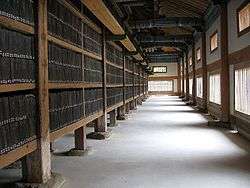
.jpg)
The history of Korea begins with the founding of Joseon (often known as "Gojoseon" to prevent confusion with another dynasty founded in the 14th century; the prefix Go- means 'older,' 'before,' or 'earlier') in 2333 BC by Dangun, according to Korean foundation mythology.[59][60]
Gojoseon expanded until it controlled northern Korean Peninsula and some parts of Manchuria. Gija Joseon was purportedly founded in the 12th century BC, and its existence and role have been controversial in the modern era.[60][61]
In the 2nd century BC, Wiman Joseon fell to Han China near the end of the century. Later the Han Dynasty set up Four Commanderies of Han in 108 BC. There was a significant Chinese presence in northern parts of the Korean peninsula during the next century, and the Lelang Commandery persisted for about 400 years until it was conquered by Goguryeo.[62] After many conflicts with the Chinese Han Dynasty, Gojoseon disintegrated, leading to the Proto–Three Kingdoms of Korea period.
Three Kingdoms of Korea
In the early centuries AD, Buyeo, Okjeo, Dongye, and the Samhan confederacy occupied the peninsula and southern Manchuria. Of the various states, Goguryeo, Baekje, and Silla grew to control the peninsula as the Three Kingdoms of Korea. Goguryeo, the largest and most powerful among them, was a highly militaristic state,[63][64] and competed with various Chinese dynasties during its 700 years of history. Goguryeo experienced a golden age under Gwanggaeto the Great and his son Jangsu,[65][66][67][68] who both subdued Baekje and Silla during their times, achieving a brief unification of the Three Kingdoms of Korea and becoming the most dominant power on the Korean Peninsula.[69][70] In addition to contesting for control of the Korean Peninsula, Goguryeo had many military conflicts with various Chinese dynasties,[71] most notably the Goguryeo–Sui War, in which Goguryeo defeated a huge force said to number over a million men.[72][73][74][75][76] Baekje was a great maritime power;[77] its nautical skill, which made it the Phoenicia of East Asia, was instrumental in the dissemination of Buddhism throughout East Asia and continental culture to Japan.[78][79] Baekje was once a great military power on the Korean Peninsula, especially during the time of Geunchogo,[80] but was critically defeated by Gwanggaeto the Great and declined.[81] Silla was the smallest and weakest of the three, but it used cunning diplomatic means to make opportunistic pacts and alliances with the more powerful Korean kingdoms, and eventually Tang China, to its great advantage.[82][83]
North–South Kingdoms
The unification of the Three Kingdoms by Silla in 676 led to the North South States Period, in which much of the Korean Peninsula was controlled by Later Silla, while Balhae controlled the northern parts of Goguryeo. Balhae was founded by a Goguryeo general and formed as a successor state to Goguryeo. During its height, Balhae controlled most of Manchuria and parts of the Russian Far East.
Later Silla was a golden age of art and culture,[84][85][86][87] as evidenced by the Hwangnyongsa, Seokguram, and Emille Bell. Relationships between Korea and China remained relatively peaceful during this time. Later Silla carried on the maritime prowess of Baekje, which acted like the Phoenicia of medieval East Asia,[88] and during the 8th and 9th centuries dominated the seas of East Asia and the trade between China, Korea and Japan, most notably during the time of Jang Bogo; in addition, Silla people made overseas communities in China on the Shandong Peninsula and the mouth of the Yangtze River.[89][90][91][92] Later Silla was a prosperous and wealthy country,[93] and its metropolitan capital of Gyeongju[94] was the fourth largest city in the world.[95][96][97][98] Buddhism flourished during this time, and many Korean Buddhists gained great fame among Chinese Buddhists[99] and contributed to Chinese Buddhism,[100] including: Woncheuk, Wonhyo, Uisang, Musang,[101][102][103][104] and Kim Gyo-gak, a Silla prince whose influence made Mount Jiuhua one of the Four Sacred Mountains of Chinese Buddhism.[105][106][107][108][109] However, Later Silla weakened under internal strife and the revival of Baekje and Goguryeo, which led to the Later Three Kingdoms period in the late 9th century.
Goryeo
In 936, the Later Three Kingdoms were united by Wang Geon, a descendant of Goguryeo nobility,[110][111] who established Goryeo as the successor state of Goguryeo.[46][47][48][49] Balhae had fallen to the Khitan Empire in 926, and a decade later the last crown prince of Balhae fled south to Goryeo, where he was warmly welcomed and included into the ruling family by Wang Geon, thus unifying the two successor nations of Goguryeo.[112] Like Silla, Goryeo was a highly cultural state and created the Jikji in 1377, using the world's oldest metal movable type printing press.[54][55][56][57][58][113][114] After defeating the Khitan Empire, which was the most powerful empire of its time,[115][116] in the Goryeo–Khitan War, Goryeo experienced a golden age that lasted a century, during which the Tripitaka Koreana was completed and there were great developments in printing and publishing, promoting learning and dispersing knowledge on philosophy, literature, religion, and science; by 1100, there were 12 universities that produced famous scholars and scientists.[117][118] However, the Mongol invasions in the 13th century greatly weakened the kingdom. Goryeo was never conquered by the Mongols, but exhausted after three decades of fighting, the Korean court sent its crown prince to the Yuan capital to swear allegiance to Kublai Khan, who accepted, and married one of his daughters to the Korean crown prince.[119] Henceforth, Goryeo continued to rule Korea, though as a tributary ally to the Mongols for the next 86 years. During this period, the two nations became intertwined as all subsequent Korean kings married Mongol princesses,[119] and the last empress of the Yuan dynasty was a Korean princess.[120] After the Mongolian Empire collapsed, severe political strife followed and the Goryeo Dynasty was replaced by the Joseon Dynasty in 1392, following a rebellion by General Yi Seong-gye.
Joseon
King Taejo declared the new name of Korea as "Joseon" in reference to Gojoseon, and moved the capital to Hanseong (one of the old names of Seoul).[121] The first 200 years of the Joseon dynasty were marked by peace, and saw great advancements in science[122][123] and education,[124] as well as the creation of Hangul by Sejong the Great to promote literacy among the common people.[25] The prevailing ideology of the time was Neo-Confucianism, which was epitomized by the seonbi class: nobles who passed up positions of wealth and power to lead lives of study and integrity.
Between 1592 and 1598, Japan invaded Korea. Toyotomi Hideyoshi led the Japanese forces, but his advance was halted by Korean forces (most notably the Joseon Navy led by Admiral Yi Sun-sin and his renowned "turtle ship")[125][126][127][128][129] with assistance from Righteous Army militias formed by Korean civilians, and Ming Dynasty Chinese troops. Through a series of successful battles of attrition, the Japanese forces were eventually forced to withdraw, and relations between all parties became normalized. In 1627 and 1637, Joseon suffered two separate invasions by the Manchu, which also extended to China and led to the conquest of the Ming Dynasty. After the second Manchu invasion in 1637, Joseon experienced a nearly 200-year period of peace. Kings Yeongjo and Jeongjo particularly led a new renaissance of the Joseon Dynasty during the 18th century.[130][131]
However, the latter years of the Joseon Dynasty were marked by isolation from the outside world. During the 19th century, Korea's isolationist policy earned it the name the "Hermit Kingdom". The Joseon Dynasty tried to protect itself against Western imperialism, but was eventually forced to open trade. After the First Sino-Japanese War and the Russo-Japanese War, Korea was occupied by Japan (1910–45). At the end of World War II, the Japanese surrendered to Soviet and U.S. forces who occupied the northern and southern halves of Korea, respectively.
South Korea
Despite the initial plan of a unified Korea in the 1943 Cairo Declaration, escalating Cold War antagonism between the Soviet Union and the United States eventually led to the establishment of separate governments, each with its own ideology, leading to the division of Korea into two political entities in 1948: North Korea and South Korea.
In the South, Syngman Rhee, an opponent of communism, who had been backed and appointed by the United States as head of the provisional government, won the first presidential elections of the newly declared Republic of Korea in May. In the North, a former anti-Japanese guerrilla and communist activist, Kim Il-sung was appointed premier of the Democratic People's Republic of Korea in September. In October the Soviet Union declared Kim Il-sung's government as sovereign over both parts. The UN declared Rhee's government as "a lawful government having effective control and jurisdiction over that part of Korea where the UN Temporary Commission on Korea was able to observe and consult" and the Government "based on elections which was observed by the Temporary Commission" in addition to a statement that "this is the only such government in Korea."[132] Both leaders began an authoritarian repression of their political opponents inside their region, seeking for a unification of Korea under their control. While South Korea's request for military support was denied by the United States, North Korea's military was heavily reinforced by the Soviet Union.
On June 25, 1950, North Korea invaded South Korea, sparking the Korean War, the Cold War's first major conflict, which continued until 1953. At the time, the Soviet Union had boycotted the United Nations (UN), thus forfeiting their veto rights. This allowed the UN to intervene in a civil war when it became apparent that the superior North Korean forces would unify the entire country. The Soviet Union and China backed North Korea, with the later participation of millions of Chinese troops. After an ebb and flow that saw both sides almost pushed to the brink of extinction, and massive losses among Korean civilians in both the north and the south, the war eventually reached a stalemate. The 1953 armistice, never signed by South Korea, split the peninsula along the demilitarized zone near the original demarcation line. No peace treaty was ever signed, resulting in the two countries remaining technically at war. Over 1.2 million people died during the Korean War.[133]
_growth_from_1911_to_2008.png)
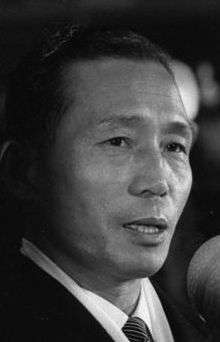
In 1960, a student uprising (the "April 19 Revolution") led to the resignation of the autocratic, corrupt President Syngman Rhee. A period of political instability followed, broken by General Park Chung-hee's May 16 coup against the weak and ineffectual government the next year. Park took over as president until his assassination in 1979, overseeing rapid export-led economic growth as well as implementing political repression. Park was heavily criticised as a ruthless military dictator, who in 1972 extended his rule by creating a new constitution, which gave the president sweeping (almost dictatorial) powers and permitted him to run for an unlimited number of six-year terms. However, the Korean economy developed significantly during Park's tenure and the government developed the nationwide expressway system, the Seoul subway system, and laid the foundation for economic development during his 17-year tenure.
.png)
The years after Park's assassination were marked again by political turmoil, as the previously suppressed opposition leaders all campaigned to run for president in the sudden political void. In 1979 there came the Coup d'état of December Twelfth led by General Chun Doo-hwan. Following the Coup d'état, Chun Doo-hwan planned to rise to power through several measures. On May 17, Chun Doo-hwan forced the Cabinet to expand martial law to the whole nation, which had previously not applied to the island of Jejudo. The expanded martial law closed universities, banned political activities and further curtailed the press. Chun's assumption of the presidency in the events of May 17, triggered nationwide protests demanding democracy, in particular in the city of Gwangju, to which Chun sent special forces to violently suppress the Gwangju Democratization Movement.[135]
Chun subsequently created the National Defense Emergency Policy Committee and took the presidency according to his political plan. Chun and his government held South Korea under a despotic rule until 1987, when a Seoul National University student, Park Jong-chul, was tortured to death.[136] On June 10, the Catholic Priests Association for Justice revealed the incident, igniting the June Democracy Movement around the country. Eventually, Chun's party, the Democratic Justice Party, and its leader, Roh Tae-woo announced the 6.29 Declaration, which included the direct election of the president. Roh went on to win the election by a narrow margin against the two main opposition leaders, Kim Dae-Jung and Kim Young-Sam.
In 1988, Seoul hosted the 1988 Summer Olympics. It became a member of the Organization for Economic Co-operation and Development (OECD) in 1996.[137] It was adversely affected by the 1997 Asian Financial Crisis. However, the country recovered and continued its economic growth, albeit at a slower pace.

In June 2000, as part of president Kim Dae-jung's "Sunshine Policy" of engagement, a North–South summit took place in Pyongyang, the capital of North Korea. Later that year, Kim received the Nobel Peace Prize "for his work for democracy and human rights in South Korea and in East Asia in general, and for peace and reconciliation with North Korea in particular."[138] However, because of discontent among the population for fruitless approaches to the North under the previous administrations and, amid North Korean provocations, a conservative government was elected in 2007 led by President Lee Myung-bak, former mayor of Seoul. More recently, Park Geun-hye won the South Korean presidential election, 2012.
In 2002, South Korea and Japan jointly co-hosted the 2002 FIFA World Cup. However, South Korean and Japanese relations later soured because of conflicting claims of sovereignty over the Liancourt Rocks, in what became known as the Liancourt Rocks dispute.
In 2016, a South-Korean political scandal raised accusing President Park Geun-hye's administration for the involvement of Choi Soon Li in state affairs, wherefore Soon Li was officially charged in November 2016. Following the scandal, there has been a serie of massive demonstrations that started in the first week of November 2016.[139]
Geography, climate and environment
Geography
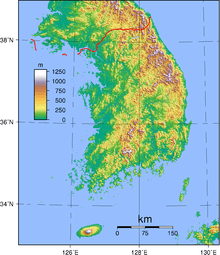
South Korea occupies the southern portion of the Korean Peninsula, which extends some 1,100 km (680 mi) from the Asian mainland. This mountainous peninsula is flanked by the Yellow Sea to the west, and the East Sea to the east. Its southern tip lies on the Korea Strait and the East China Sea.
The country, including all its islands, lies between latitudes 33° and 39°N, and longitudes 124° and 130°E. Its total area is 100,032 square kilometres (38,622.57 sq mi).[140]
South Korea can be divided into four general regions: an eastern region of high mountain ranges and narrow coastal plains; a western region of broad coastal plains, river basins, and rolling hills; a southwestern region of mountains and valleys; and a southeastern region dominated by the broad basin of the Nakdong River.[141]
South Korea's terrain is mostly mountainous, most of which is not arable. Lowlands, located primarily in the west and southeast, make up only 30% of the total land area.
About three thousand islands, mostly small and uninhabited, lie off the western and southern coasts of South Korea. Jeju-do is about 100 kilometres (62 miles) off the southern coast of South Korea. It is the country's largest island, with an area of 1,845 square kilometres (712 square miles). Jeju is also the site of South Korea's highest point: Hallasan, an extinct volcano, reaches 1,950 metres (6,400 feet) above sea level. The easternmost islands of South Korea include Ulleungdo and Liancourt Rocks (Dokdo/Takeshima), while Marado and Socotra Rock are the southernmost islands of South Korea.[141]
South Korea has 20 national parks and popular nature places like the Boseong Tea Fields, Suncheon Bay Ecological Park, and the first national park of Jirisan.[142]
Climate
| Seoul | ||||||||||||||||||||||||||||||||||||||||||||||||||||||||||||
|---|---|---|---|---|---|---|---|---|---|---|---|---|---|---|---|---|---|---|---|---|---|---|---|---|---|---|---|---|---|---|---|---|---|---|---|---|---|---|---|---|---|---|---|---|---|---|---|---|---|---|---|---|---|---|---|---|---|---|---|---|
| Climate chart (explanation) | ||||||||||||||||||||||||||||||||||||||||||||||||||||||||||||
| ||||||||||||||||||||||||||||||||||||||||||||||||||||||||||||
| ||||||||||||||||||||||||||||||||||||||||||||||||||||||||||||
South Korea tends to have a humid continental climate and a humid subtropical climate, and is affected by the East Asian monsoon, with precipitation heavier in summer during a short rainy season called jangma (장마), which begins end of June through the end of July. Winters can be extremely cold with the minimum temperature dropping below −20 °C (−4 °F) in the inland region of the country: in Seoul, the average January temperature range is −7 to 1 °C (19 to 34 °F), and the average August temperature range is 22 to 30 °C (72 to 86 °F). Winter temperatures are higher along the southern coast and considerably lower in the mountainous interior.[144] Summer can be uncomfortably hot and humid, with temperatures exceeding 30 °C (86 °F) in most parts of the country. South Korea has four distinct seasons; spring, summer, autumn and winter. Spring usually lasts from late-March to early-May, summer from mid-May to early-September, autumn from mid-September to early-November, and winter from mid-November to mid-March.
Rainfall is concentrated in the summer months of June through September. The southern coast is subject to late summer typhoons that bring strong winds, heavy rains and sometime floods. The average annual precipitation varies from 1,370 millimetres (54 in) in Seoul to 1,470 millimetres (58 in) in Busan.
Environment
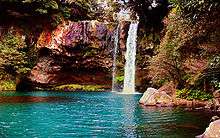
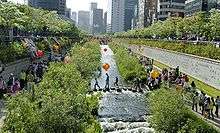
During the first 20 years of South Korea's growth surge, little effort was made to preserve the environment.[145] Unchecked industrialization and urban development have resulted in deforestation and the ongoing destruction of wetlands such as the Songdo Tidal Flat.[146] However, there have been recent efforts to balance these problems, including a government run $84 billion five-year green growth project that aims to boost energy efficiency and green technology.[147]
The green-based economic strategy is a comprehensive overhaul of South Korea's economy, utilizing nearly two percent of the national GDP. The greening initiative includes such efforts as a nationwide bike network, solar and wind energy, lowering oil dependent vehicles, backing daylight savings and extensive usage of environmentally friendly technologies such as LEDs in electronics and lighting.[148] The country – already the world's most wired – plans to build a nationwide next-generation network which will be 10 times faster than broadband facilities in order to reduce energy usage.[148]
The renewable portfolio standard program with renewable energy certificates runs from 2012 to 2022.[149] Quota systems favor large, vertically integrated generators and multinational electric utilities, if only because certificates are generally denominated in units of one megawatt-hour. They are also more difficult to design and implement than a Feed-in tariff.[150] Around 350 residential micro combined heat and power units were installed in 2012.[151]
Seoul's tap water recently became safe to drink, with city officials branding it "Arisu" in a bid to convince the public.[152] Efforts have also been made with afforestation projects. Another multibillion-dollar project was the restoration of Cheonggyecheon, a stream running through downtown Seoul that had earlier been paved over by a motorway.[153] One major challenge is air quality, with acid rain, sulfur oxides, and annual yellow dust storms being particular problems.[145] It is acknowledged that many of these difficulties are a result of South Korea's proximity to China, which is a major air polluter.[145]
South Korea is a member of the Antarctic-Environmental Protocol, Antarctic Treaty, Biodiversity Treaty, Kyoto Protocol (forming the Environmental Integrity Group (EIG), regarding UNFCCC,[154] with Mexico and Switzerland), Desertification, Endangered Species, Environmental Modification, Hazardous Wastes, Law of the Sea, Marine Dumping, Comprehensive Nuclear-Test-Ban Treaty (not into force), Ozone Layer Protection, Ship Pollution, Tropical Timber 83, Tropical Timber 94, Wetlands, and Whaling.[9]
Government
Under its current constitution the state is sometimes referred to as the Sixth Republic of South Korea. Like many democratic states,[155] South Korea has a government divided into three branches: executive, judicial, and legislative. The executive and legislative branches operate primarily at the national level, although various ministries in the executive branch also carry out local functions. Local governments are semi-autonomous, and contain executive and legislative bodies of their own. The judicial branch operates at both the national and local levels. South Korea is a constitutional democracy.
The South Korean government's structure is determined by the Constitution of the Republic of Korea. This document has been revised several times since its first promulgation in 1948 at independence. However, it has retained many broad characteristics and with the exception of the short-lived Second Republic of South Korea, the country has always had a presidential system with an independent chief executive.[156] The first direct election was also held in 1948. Although South Korea experienced a series of military dictatorships from the 1960s up until the 1980s, it has since developed into a successful liberal democracy. Today, the CIA World Factbook describes South Korea's democracy as a "fully functioning modern democracy".[157] South Korea is ranked 37th on the Corruption Perceptions Index, with moderate control on corruption.[158]
Administrative divisions
The major administrative divisions in South Korea are eight provinces, one special self-governing province, six metropolitan cities (self-governing cities that are not part of any province), one special city and one metropolitan autonomous city.
| Map | Namea | Hangul | Hanja | Populationc | |
|---|---|---|---|---|---|
| Special city (Teukbyeolsi)a | |||||
| Seoul | 서울특별시 | 서울特別市b | 9,989,795 | ||
| Metropolitan city (Gwangyeoksi)a | |||||
| Busan | 부산광역시 | 釜山廣域市 | 3,509,462 | ||
| Daegu | 대구광역시 | 大邱廣域市 | 2,484,864 | ||
| Incheon | 인천광역시 | 仁川廣域市 | 2,935,314 | ||
| Gwangju | 광주광역시 | 光州廣域市 | 1,472,285 | ||
| Daejeon | 대전광역시 | 大田廣域市 | 1,516,208 | ||
| Ulsan | 울산광역시 | 蔚山廣域市 | 1,173,143 | ||
| Metropolitan autonomous city (Teukbyeol-jachisi)a | |||||
| Sejong | 세종특별자치시 | 世宗特別自治市 | 230,327 | ||
| Province (Do)a | |||||
| Gyeonggi | 경기도 | 京畿道 | 12,610,877 | ||
| Gangwon | 강원도 | 江原道 | 1,548,603 | ||
| North Chungcheong | 충청북도 | 忠淸北道 | 1,586,943 | ||
| South Chungcheong | 충청남도 | 忠淸南道 | 2,085,844 | ||
| North Jeolla | 전라북도 | 全羅北道 | 1,865,900 | ||
| South Jeolla | 전라남도 | 全羅南道 | 1,904,314 | ||
| North Gyeongsang | 경상북도 | 慶尙北道 | 2,702,385 | ||
| South Gyeongsang | 경상남도 | 慶尙南道 | 3,368,792 | ||
| Special self-governing province (Teukbyeoljachi-do)a | |||||
| Jeju | 제주특별자치도 | 濟州特別自治道 | 634,274 | ||
a Revised Romanisation; b See Names of Seoul; c June As of 2016.[159]
Demographics
In April 2016, South Korea's population was estimated to be around 50.8 million by National Statistical Office, with continuing decline of working age population and total fertility rate.[4][5] The country is noted for its population density, which was an estimated 505 per square kilometer in 2015,[4] more than 10 times the global average. Most South Koreans live in urban areas, because of rapid migration from the countryside during the country's quick economic expansion in the 1970s, 1980s and 1990s.[160] The capital city of Seoul is also the country's largest city and chief industrial center. According to the 2005 census, Seoul had a population of 10 million inhabitants. The Seoul National Capital Area has 24.5 million inhabitants (about half of South Korea's entire population) making it the world's second largest metropolitan area. Other major cities include Busan (3.5 million), Incheon (2.5 million), Daegu (2.5 million), Daejeon (1.4 million), Gwangju (1.4 million) and Ulsan (1.1 million).[161]
The population has also been shaped by international migration. After World War II and the division of the Korean Peninsula, about four million people from North Korea crossed the border to South Korea. This trend of net entry reversed over the next 40 years because of emigration, especially to the United States and Canada. South Korea's total population in 1955 was 21.5 million,[162] and has more than doubled, to 50 million, by 2010.[163]
South Korea is one of the most ethnically homogeneous societies in the world, with more than 99% of inhabitants having Korean ethnicity.[164]
The percentage of foreign nationals has been growing rapidly.[165] As of 2009, South Korea had 1,106,884 foreign residents, 2.7% of the population; however, more than half of them are ethnic Koreans with a foreign citizenship. For example, migrants from China (PRC) make up 56.5% of foreign nationals, but approximately 70% of the Chinese citizens in Korea are Joseonjok (조선족 in Korean), PRC citizens of Korean ethnicity.[166] Regardless of the ethnicity, there are 28,500 US military personnel serving in South Korea, most serving a one-year unaccompanied tour (though approximately 10% serve longer tours accompanied by family), according to the Korea National Statistical Office.[167][168] In addition, about 43,000 English teachers from English-speaking countries reside temporarily in Korea.[169] Currently, South Korea has one of the highest rates of growth of foreign born population, with about 30,000 foreign born residences obtaining South Korean citizenship every year since 2010.
South Korea's birthrate was the world's lowest in 2009.[170] If this continues, its population is expected to decrease by 13% to 42.3 million in 2050.[171] South Korea's annual birthrate is approximately 9 births per 1000 people.[172] However, the birthrate has increased by 5.7% in 2010 and Korea no longer has the world's lowest birthrate.[173] According to a 2011 report from Chosun Ilbo, South Korea's total fertility rate (1.23 children born per woman) is higher than those of Taiwan (1.15) and Japan (1.21).[174] The average life expectancy in 2008 was 79.10 years,[175] (which was 34th in the world[176]) but by 2015 it had increased to around 81.[177] South Korea has the steepest decline in working age population of the OECD nations.[178] In 2015, National Statistical Office estimated that the population of the country would reach its peak by 2030.[4][5]
| | |||||||||
|---|---|---|---|---|---|---|---|---|---|
| Rank | Name | Province | Pop. | Rank | Name | Province | Pop. | ||
 Seoul 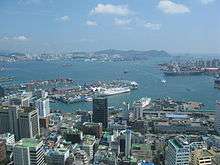 Busan |
1 | Seoul | Seoul | 9,904,312 | 11 | Yongin | Gyeonggi | 971,327 | 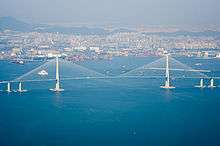 Incheon  Daegu |
| 2 | Busan | Busan | 3,448,737 | 12 | Seongnam | Gyeonggi | 948,757 | ||
| 3 | Incheon | Incheon | 2,890,451 | 13 | Bucheon | Gyeonggi | 843,794 | ||
| 4 | Daegu | Daegu | 2,446,052 | 14 | Cheongju | North Chungcheong | 833,276 | ||
| 5 | Daejeon | Daejeon | 1,538,394 | 15 | Ansan | Gyeonggi | 747,035 | ||
| 6 | Gwangju | Gwangju | 1,502,881 | 16 | Jeonju | North Jeolla | 658,172 | ||
| 7 | Suwon | Gyeonggi | 1,194,313 | 17 | Cheonan | South Chungcheong | 629,062 | ||
| 8 | Ulsan | Ulsan | 1,166,615 | 18 | Namyangju | Gyeonggi | 629,061 | ||
| 9 | Changwon | South Gyeongsang | 1,059,241 | 19 | Hwaseong | Gyeonggi | 608,725 | ||
| 10 | Goyang | Gyeonggi | 990,073 | 20 | Anyang | Gyeonggi | 585,177 | ||
Education
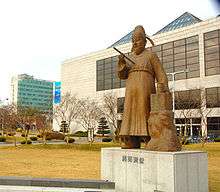
A centralized administration in South Korea oversees the process for the education of children from kindergarten to the third and final year of high school. The school year is divided into two semesters, the first of which begins in the beginning of March and ends in mid-July, the second of which begins in late August and ends in mid-February. The schedules are not uniformly standardized and vary from school to school. Most South Korean middle schools and high schools have school uniforms, modeled on western-style uniforms. Boys' uniforms usually consists of trousers and white shirts, and girls wear skirts and white shirts (this only applies in middle schools and high schools). The country adopted a new educational program to increase the number of their foreign students through 2010. According to the Ministry of Education, Science and Technology, the number of scholarships for foreign students in South Korea would have (under the program) doubled by that time, and the number of foreign students would have reached 100,000.[180]
South Korea is the top-performing OECD country in reading literacy, maths and sciences with the average student scoring 542 and has one of the worlds highest-educated labour forces among OECD countries.[181] The country is well known for its high feverish outlook on education, where it's national obsession with education has been called "education fever".[182][183][184] Higher education is an overwhelmingly serious issue in South Korea society, where it is viewed as one of the fundamental cornerstones of South Korean life. Education remains a high priority for South Korean families as success in education holds a cultural status as well as a necessity to improve one's socioeconomic position in South Korean society.[185] Academic success is often a source of pride for families and within South Korean society at large. South Koreans view education as the main propeller of social mobility for themselves and their family as a gateway to the South Korean middle class. Graduating from a top university is the ultimate marker of prestige, high socioeconomic status, promising marriage prospects, and a respectable career path. An average South Korean child's life revolves around education as pressure to succeed academically is deeply ingrained in South Korean children from an early age. Not having a university degree carries a major cultural stigma as those without university degrees face social prejudice and are often looked down upon by others.[186]
In 2015, the country spent 4.7% of its GDP on all levels of education – roughly equal to the Organization for Economic Cooperation and Development (OECD) average of 4.7% also.[187] A strong investment in education, a militant drive for success as well as the passion for excellence has helped the country rapidly grow its economy over the past 60 years from a war torn wasteland.[188] South Korea’s zeal for education and its students’ desires to get into a prestigious university is one of the highest in the world, as the entrance into a top tier higher educational institution leads to a prestigious, secure and well-paid white collar job with the government, banks, a major South Korean conglomerate such as Samsung, Hyundai or LG Electronics.[189] With incredible pressure on high school students to secure places at the nation’s best universities, its institutional reputation and alumni networks are strong predictors of future career prospects. The top three universities in South Korea, often referred to as "SKY", are Seoul National University, Korea University and Yonsei University.[190][191][192] Intense competition for top grades and academic pressure to be the top student is deeply ingrained in the psyche of South Korean students at a young age.[192] Yet with only so many places at universities and even fewer places at top-tier companies, many young people remain disappointed and are often unwilling to lower their sights. Those who do not choose to go to university can feel as underachievers as not having a university degree carries a major taboo in South Korean society where those who don't hold university degrees are looked down by others as second-class citizens resulting fewer opportunities for employment, improvement of one's socioeconomic position and prospects for marriage.[193]
International reception on the South Korean education system has been divided. It has been praised for various reasons, including its comparatively high test results and its major role in ushering South Korea's economic development creating one of the world’s most educated workforces.[194] South Korea's highly enviable academic performance has gotten British education ministers actively remodeling their own curriculum's and exams to try to emulate Korea's militant drive and passion for excellence and high educational achievement.[194] U.S. President Barack Obama has also praised the country's rigorous school system, where over 80 percent of South Korean high school graduates go on to college. The nation's high university entrance rate has created a highly skilled workforce making South Korea among the most educated countries in the world with the one of the highest percentage of its citizens holding a tertiary education degree.[195] Bachelor's degrees are held by 68 percent of South Koreans aged 25–34, the most in the OECD.[195]
The system's rigid and hierarchical structure has been criticized for stifling creativity and innovation;[196] described as intensely and "brutally" competitive,[197] The system is often blamed for the high suicide rate in the country, particularly the growing rates among those aged 10–19. Various media outlets attribute the nations high suicide rate on the nationwide anxiety around the country's college entrance exams, which determine the trajectory of students entire lives and careers.[198] Former South Korean hagwon teacher Se-Woong Koo wrote that the South Korean education system amounts to child abuse and that it should be "reformed and restructured without delay."[199] The system has also been criticized for producing an oversupply of university graduates creating an overeducated and underemployed labor force; in the first quarter of 2013 alone, nearly 3.3 million South Korean university graduates were jobless, leading many graduates overqualified for jobs requiring less education.[200] Further criticism has been stemmed for causing labor shortages in various skilled labor and vocational occupations, where many of which go unfilled as the negative social stigma associated with vocational careers and not having a university degree continues to remain deep-rooted in South Korean society.[186][201][202][203][204][205][206][207]
Religion
As of 2005, just under half of the South Korean population expressed no religious preference.[209] Of the rest, most are Buddhist or Christian. According to the 2007 census, 29.2% of the population at that time was Christian (18.3% identified themselves as Protestants, 10.9% as Roman Catholics), and 22.8% were Buddhist.[210][211] Other religions include Islam and various new religious movements such as Jeungsanism, Cheondoism and Wonbuddhism. The earliest religion practiced was Korean shamanism.[212] Today, freedom of religion is guaranteed by the constitution, and there is no state religion.[213] There is a conflict however with the long established requirement of mandatory military service which leads to the imprisonment of conscientious objectors, thereby causing many Jehovah's Witnesses to be imprisoned in South Korea for refusing on the same grounds of conscientious objection.[214][215] The UN Human Rights Committee has determined that the government of South Korea uses arbitrary detention for conscientious objectors and should take steps to resolve the issue.
Christianity is South Korea's largest religion, accounting for more than half of all South Korean religious adherents. There are approximately 13.7 million Christians in South Korea today; about 63% of Korean Christians belong to Protestant churches, while 37% belong to the Roman Catholic Church.[216] The number of Protestant Christians has slightly decreased since the 1990s, while the number of Roman Catholics has rapidly increased since the 1980s.[216][217] Presbyterian denominations are the biggest Christian denominations in South Korea. About nine million people belong to one of the 100 different Presbyterian churches; among the biggest denominations are the HapDong Presbyterian Church, TongHap Presbyterian Church, the Koshin Presbyterian Church. For more information see Presbyterianism in South Korea.[218] South Korea is also the second-largest missionary-sending nation, after the United States.[219]
Buddhism was introduced to Korea in the year 372.[220] According to the national census as of 2005, South Korea has over 10.7 million Buddhists.[221][222] Today, about 90% of Korean Buddhists belong to Jogye Order. Most of the National Treasures of South Korea are Buddhist artifacts. Buddhism became the state religion in some of Korean kingdoms since the Three Kingdoms Period, when Goguryeo adopted it as the state religion in 372, followed by Baekje (528). Buddhism had been the state religion of Unified Silla from the North South States Period (not to be confused with the modern division of Korea) to Goryeo before suppression under the Joseon dynasty in favor of Neo-Confucianism.[223]
Fewer than 30,000 South Koreans are thought to be Muslims, but the country has some 100,000 resident foreign workers from Islamic countries such as Bangladesh, Indonesia and Pakistan.[224]
Korean shamanism, today known as Muism (religion of the mu [shamans]) or Sinism (religion of the gods) encompasses a variety of indigenous religious beliefs and practices of the Korean people and the Korean sphere.[225] In contemporary South Korea, the most used term is Muism and a shaman is known as a mudang (무당, 巫堂) or Tangol (당골). Since the early 2000s, this religion has regained popularity among Koreans.[226][227][228][229]
Health

South Korea has a universal healthcare system.[230]
Korean hospitals have advanced medical equipment and facilities readily available, ranking 4th for MRI units per capita and 6th for CT scanners per capita in the OECD.[231] It also had the OECD's second largest number of hospital beds per 1000 people at 9.56 beds, which was over triple that of Sweden's 2.71, Canada's 2.75, the UK's 2.95 or the United States' 3.05 beds.
Life expectancy has been rising rapidly and Korea ranked 9th in the world for life expectancy at 82 years in 2013, ranking 4th in the world at 85 years.
Foreign relations
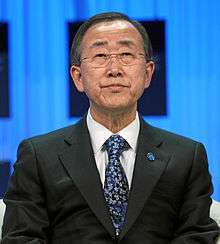
South Korea maintains diplomatic relations with more than 188 countries. The country has also been a member of the United Nations since 1991, when it became a member state at the same time as North Korea. On January 1, 2007, South Korean Foreign Minister Ban Ki-moon assumed the post of UN Secretary-General. It has also developed links with the Association of Southeast Asian Nations as both a member of ASEAN Plus three, a body of observers, and the East Asia Summit (EAS).
In 2010, South Korea and the European Union concluded a free trade agreement (FTA) to reduce trade barriers. South Korea is also negotiating a Free Trade Agreement with Canada,[232] and another with New Zealand.[233] In November 2009 South Korea joined the OECD Development Assistance Committee, marking the first time a former aid recipient country joined the group as a donor member. South Korea hosted the G-20 Summit in Seoul in November 2010.
China
Historically, Korea has had close relations with China. Before the formation of South Korea, Korean independence fighters worked with Chinese soldiers during the Japanese occupation. However, after World War II, the People's Republic of China embraced Maoism while South Korea sought close relations with the United States. The PRC assisted North Korea with manpower and supplies during the Korean War, and in its aftermath the diplomatic relationship between South Korea and the PRC almost completely ceased. Relations thawed gradually and South Korea and the PRC re-established formal diplomatic relations on August 24, 1992. The two countries sought to improve bilateral relations and lifted the forty-year-old trade embargo,[234] and South Korean–Chinese relations have improved steadily since 1992.[234] The Republic of Korea broke off official relations with the Republic of China (Taiwan) upon gaining official relations with the People's Republic of China, which doesn't recognise Taiwan's sovereignty.[235]
European Union
The European Union (EU) and South Korea are important trading partners, having negotiated a free trade agreement for many years since South Korea was designated as a priority FTA partner in 2006. The free trade agreement was approved in September 2010, and took effect on July 1, 2011.[236] South Korea is the EU's eighth largest trade partner, and the EU has become South Korea's second largest export destination. EU trade with South Korea exceeded €65 billion in 2008 and has enjoyed an annual average growth rate of 7.5% between 2004 and 2008.[237]
The EU has been the single largest foreign investor in South Korea since 1962, and accounted for almost 45% of all FDI inflows into Korea in 2006. Nevertheless, EU companies have significant problems accessing and operating in the South Korean market because of stringent standards and testing requirements for products and services often creating barriers to trade. Both in its regular bilateral contacts with South Korea and through its FTA with Korea, the EU is seeking to improve this situation.[237]
Japan

Although there were no formal diplomatic ties between South Korea and Japan after the end of World War II, South Korea and Japan signed the Treaty on Basic Relations between Japan and the Republic of Korea in 1965 to establish diplomatic ties. There is heavy anti-Japanese sentiment in South Korea because of a number of unsettled Japanese-Korean disputes, many of which stem from the period of Japanese occupation after the Japanese annexation of Korea. During World War II, more than 100,000 Koreans served in the Imperial Japanese Army.[238][239] Korean women were forced to the war front to serve the Imperial Japanese Army as sexual slaves, called comfort women.[240][241][242][243]
Longstanding issues such as Japanese war crimes against Korean civilians, visits by Japanese politicians to Yasukuni Shrine honoring Japanese soldiers killed at war (including some class A war criminals), the negationist re-writing of Japanese textbooks relating Japanese atrocities during World War II, and the territorial disputes over Liancourt Rocks, known in South Korea as "Dokdo",[244] continue to trouble Korean-Japanese relations. Although Dokdo is claimed by both South Korea and Japan, the islets are administered by South Korea, which had its coast guard stationed there.[245][246]
In response to then-Prime Minister Junichiro Koizumi's visits to Yasukuni Shrine, former President Roh Moo-hyun suspended all summit talks between South Korea and Japan in 2009.[247]
North Korea
Both North and South Korea continue to officially claim sovereignty over the entire peninsula and any outlying islands. Despite the animosity, reconciliation efforts have been present from the very beginning of the separation between North and South Korea. Political figures such as Kim Koo worked to reconcile the two governments even after the Korean War.[248] With longstanding animosity following the Korean War from 1950 to 1953, North Korea and South Korea signed an agreement to pursue peace.[249] On October 4, 2007, Roh Moo-Hyun and North Korean leader Kim Jong-il signed an eight-point agreement on issues of permanent peace, high-level talks, economic cooperation, renewal of train services, highway and air travel, and a joint Olympic cheering squad.[249]
Despite the Sunshine Policy and efforts at reconciliation, the progress was complicated by North Korean missile tests in 1993, 1998, 2006, 2009, and 2013. As of early 2009, relationships between North and South Korea were very tense; North Korea had been reported to have deployed missiles,[250] ended its former agreements with South Korea,[251] and threatened South Korea and the United States not to interfere with a satellite launch it had planned.[252] North and South Korea are still technically at war (having never signed a peace treaty after the Korean War) and share the world's most heavily fortified border.[253] On May 27, 2009, North Korean media declared that the Armistice is no longer valid because of the South Korean government's pledge to "definitely join" the Proliferation Security Initiative.[254] To further complicate and intensify strains between the two nations, the sinking of the South Korean warship Cheonan in March 2010, is affirmed by the South Korean government[255] to have been caused by a North Korean torpedo, which the North denies. President Lee Myung-bak declared in May 2010 that Seoul would cut all trade with North Korea as part of measures primarily aimed at striking back at North Korea diplomatically and financially, except for the joint Kaesong Industrial Project, and humanitarian aid.[256] North Korea initially threatened to sever all ties, to completely abrogate the previous pact of non-aggression, and to expel all South Koreans from a joint industrial zone in Kaesong, but backtracked on its threats and decided to continue its ties with South Korea. Despite the continuing ties, Kaesong industrial zone has seen a large decrease in investment and manpower as a result of this military conflict. In February 2016, the Kaesong complex was closed by Seoul in reaction to North Korea's launch of a rocket earlier in the month[257] unanimously condemned by the United Nations security council.[258]
United States

The United States engaged in the decolonization of Korea (mainly in the South, with the Soviet Union engaged in North Korea) from Japan after World War II. After three years of military administration by the United States, the South Korean government was established. Upon the onset of the Korean War, U.S. forces were sent to defend against an invasion from North Korea of the South. Following the Armistice, South Korea and the U.S. agreed to a "Mutual Defense Treaty", under which an attack on either party in the Pacific area would summon a response from both.[259] In 1967, South Korea obliged the mutual defense treaty, by sending a large combat troop contingent to support the United States in the Vietnam War. The U.S. Eighth Army, Seventh Air Force, and U.S. Naval Forces Korea are stationed in South Korea. The two nations have strong economic, diplomatic, and military ties, although they have at times disagreed with regard to policies towards North Korea, and with regard to some of South Korea's industrial activities that involve usage of rocket or nuclear technology. There had also been strong anti-American sentiment during certain periods, which has largely moderated in the modern day.[260] In 2007, a free trade agreement known as the Republic of Korea-United States Free Trade Agreement (KORUS FTA) was signed between South Korea and the United States, but its formal implementation was repeatedly delayed, pending approval by the legislative bodies of the two countries. On October 12, 2011, the U.S. Congress passed the long-stalled trade agreement with South Korea.[261] It went into effect on March 15, 2012.[262]
Military
A long history of invasions by neighbors and the unresolved tension with North Korea have prompted South Korea to allocate 2.6% of its GDP and 15% of all government spending to its military (Government share of GDP: 14.967%), while maintaining compulsory conscription for men.[263] Consequently, South Korea has the world's sixth largest number of active troops (650,000 in 2011),[264] the world's second-largest number of reserve troops (3,200,000 in 2011)[264] and the eleventh largest defense budget. The Republic of Korea, with both regular and reserve military force numbering 3.7 million regular personnel among a total national population of 50 million people, has the second highest number of soldiers per capita in the world,[264] after the Democratic People's Republic of Korea.[265]
The South Korean military consists of the Army (ROKA), the Navy (ROKN), the Air Force (ROKAF), and the Marine Corps (ROKMC), and reserve forces.[266] Many of these forces are concentrated near the Korean Demilitarized Zone. All South Korean males are constitutionally required to serve in the military, typically 21 months. Previously, Koreans of mixed race were exempt from military duty but no exception from 2011.[267]
_returns_to_Joint_Base_Pearl_Harbor-Hickam_after_participating_in_Rim_of_the_Pacific_(RIMPAC)_2010_exercises.jpg)
In addition to male conscription in South Korea's sovereign military, 1,800 Korean males are selected every year to serve 21 months in the KATUSA Program to further augment the United States Forces Korea (USFK).[268] In 2010, South Korea was spending ₩1.68 trillion in a cost-sharing agreement with the US to provide budgetary support to the US forces in Korea, on top of the ₩29.6 trillion budget for its own military.
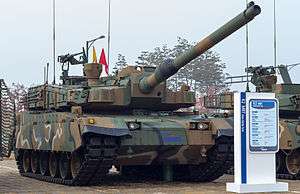
The South Korean army has 2,500 tanks in operation, including the K1A1 and K2 Black Panther, which form the backbone of the South Korean army's mechanized armor and infantry forces. A sizable arsenal of many artillery systems, including 1,700 self-propelled K55 and K9 Thunder howitzers and 680 helicopters and UAVs of numerous types, are assembled to provide additional fire, reconnaissance, and logistics support. South Korea's smaller but more advanced artillery force and wide range of airborne reconnaissance platforms are pivotal in the counter-battery suppression of North Korea's large artillery force, which operates more than 13,000 artillery systems deployed in various state of fortification and mobility.[264][269]
The South Korean navy has made its first major transformation into a blue-water navy through the formation of the Strategic Mobile Fleet, which includes a battle group of Chungmugong Yi Sun-sin class destroyers, Dokdo class amphibious assault ship, AIP-driven Type 214 submarines, and King Sejong the Great class destroyers, which is equipped with the latest baseline of Aegis fleet-defense system that allows the ships to track and destroy multiple cruise missiles and ballistic missiles simultaneously, forming an integral part of South Korea's indigenous missile defense umbrella against the North Korean military's missile threat.[270]
The South Korean air force operates 840 aircraft, making it world's ninth largest air force, including several types of advanced fighters like F-15K, heavily modified KF-16C/D,[271] and the indigenous F/A-50,[272][273] supported by well-maintained fleets of older fighters such as F-4E and KF-5E/F that still effectively serve the air force alongside the more modern aircraft. In an attempt to gain strength in terms of not just numbers but also modernity, the commissioning of four Boeing 737 AEW&C aircraft, under Project Peace Eye for centralized intelligence gathering and analysis on a modern battlefield, will enhance the fighters' and other support aircraft's ability to perform their missions with awareness and precision.
In May 2011, Korea Aerospace Industries Ltd., South Korea's largest plane maker, signed a $400 million deal to sell 16 T-50 Golden Eagle trainer jets to Indonesia, making South Korea the first country in Asia to export supersonic jets.[274]
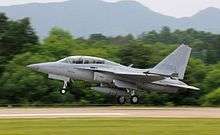
From time to time, South Korea has sent its troops overseas to assist American forces. It has participated in most major conflicts that the United States has been involved in the past 50 years. South Korea dispatched 325,517 troops to fight alongside American, Australian, Filipino, New Zealand and South Vietnamese soldiers in the Vietnam War, with a peak strength of 50,000.[275] In 2004, South Korea sent 3,300 troops of the Zaytun Division to help re-building in northern Iraq, and was the third largest contributor in the coalition forces after only the US and Britain.[276] Beginning in 2001, South Korea had so far deployed 24,000 troops in the Middle East region to support the War on Terrorism. A further 1,800 were deployed since 2007 to reinforce UN peacekeeping forces in Lebanon.
.jpg)
The United States has stationed a substantial contingent of troops in South Korea since the Korean War to defend South Korea in case of East Asian military crises. There are approximately 28,500 U.S. Military personnel stationed in Korea,[277] most of them serving one year unaccompanied tours. The American troops, which are primarily ground and air units, are assigned to USFK and mainly assigned to the Eighth United States Army of the US Army and Seventh Air Force of the US Air Force. They are stationed in installations at Osan, Kunsan, Yongsan, Dongducheon, Sungbuk, Camp Humphreys, and Daegu, as well as at Camp Bonifas in the DMZ Joint Security Area. A still functioning UN Command is technically the top of the chain of command of all forces in South Korea, including the US forces and the entire South Korean military – if a sudden escalation of war between North and South Korea were to occur the United States would assume control of the South Korean armed forces in all military and paramilitary moves. However, in September 2006, the Presidents of the United States and the Republic of Korea agreed that South Korea should assume the lead for its own defense. In early 2007, the U.S. Secretary of Defense and ROK Minister of National Defense determined that South Korea will assume wartime operational control of its forces on December 1, 2015. USFK will transform into a new joint-warfighting command, provisionally described as Korea Command (KORCOM).[278]
Economy

South Korea's mixed economy[279][280][281] ranks 11th nominal and 13th purchasing power parity GDP in the world, identifying it as one of the G-20 major economies. It is a developed country with a high-income economy and is the most industrialized member country of the OECD. South Korean brands such as LG Electronics and Samsung are internationally famous.
With its massive investment in education has taken the country from mass illiteracy to a major international technological powerhouse. South Korea's economy was one of the world's fastest-growing from the early 1960s to the late 1990s, and South Korea is still one of the fastest-growing developed countries in the 2000s, along with Hong Kong, Singapore, and Taiwan, the other three Asian Tigers.[282] South Koreans refer to this growth as the Miracle on the Han River.[283] The South Korean economy is heavily dependent on international trade, and in 2014, South Korea was the 5th largest exporter and 7th largest importer in the world.
South Korea hosted the fifth G20 summit in its capital city, Seoul, in November 2010. The two-day summit was expected to boost South Korea's economy by 31 trillion won, or 4% of South Korea's 2010 GDP, in economic effects, and create over 160,000 jobs in South Korea. It may also help improve the country's sovereign credit rating.[284]
Despite the South Korean economy's high growth potential and apparent structural stability, the country suffers damage to its credit rating in the stock market because of the belligerence of North Korea in times of deep military crises, which has an adverse effect on South Korean financial markets.[285][286] The International Monetary Fund compliments the resilience of the South Korean economy against various economic crises, citing low state debt and high fiscal reserves that can quickly be mobilized to address financial emergencies.[287] Although it was severely harmed by the Asian economic crisis of the late 1990s, the South Korean economy managed a rapid recovery and subsequently tripled its GDP.[288]
Furthermore, South Korea was one of the few developed countries that were able to avoid a recession during the global financial crisis.[289] Its economic growth rate reached 6.2 percent in 2010 (the fastest growth for eight years after significant growth by 7.2 percent in 2002),[290] a sharp recovery from economic growth rates of 2.3% in 2008 and 0.2% in 2009, when the global financial crisis hit. The unemployment rate in South Korea also remained low in 2009, at 3.6%.[291]
The following list includes the largest South Korean companies by revenue in 2013 who are all listed as part of the Fortune Global 500:
| Rank[292] | Name | Headquarters | Revenue (Mil. $) | Profit (Mil. $) | Assets (Mil. $) |
|---|---|---|---|---|---|
| 1. | Samsung Electronics | Suwon | 208,938 | 27,245 | 202,876 |
| 2. | SK Holdings | Seoul | 102,122 | 258.2 | 87,716 |
| 3. | Hyundai Motor | Seoul | 79,766 | 7,804 | 126,441 |
| 4. | POSCO | Pohang | 56,520 | 1,257 | 80,037 |
| 5. | LG Electronics | Seoul | 53,118 | 161.5 | 33,669 |
| 6. | Hyundai Heavy Industries | Ulsan | 49,507 | 254.6 | 50,421 |
| 7. | Korea Electric Power | Naju | 49,072 | 54.8 | 147,391 |
| 8. | Kia Motors | Seoul | 43,486 | 3,487 | 34,289 |
| 9. | GS Caltex | Seoul | 41,715 | 341.4 | 21,119 |
| 10. | Hanwha | Seoul | 35,379 | 118.8 | 107,394 |
| 11. | Korea Gas | Daegu | 34,774 | −183.4 | 41,382 |
| 12. | Hyundai Mobis | Seoul | 31,244 | 3,126 | 32,629 |
| 13. | S-Oil | Seoul | 28,467 | 264.6 | 11,297 |
| 14. | Samsung Life Insurance | Seoul | 26,167 | 832.6 | 182,855 |
| 15. | Samsung C&T | Seoul | 25,977 | 221.5 | 24,133 |
| 16. | Lotte Shopping | Seoul | 25,774 | 720.3 | 36,933 |
| 17. | LG Display | Seoul | 24,697 | 389.3 | 20,579 |
South Korean Pension Policy
The National Pension System
The South Korean pension system was created to provide benefits to persons reaching old age, families and persons stricken with death of their primary breadwinner, and for the purposes of stabilizing its nations welfare state.[293] South Korea’s pensions system structure is primarily based on taxation and is income-related. In 2007 there was a total of 18,367,000 insured individuals with only around 511,000 persons excluded from mandatory contribution.[294] The current pension system is divided into four categories distributing benefits to participants through national, military personnel, governmental, and private school teacher pension schemes.[295] The national pension scheme is the primary welfare system providing allowances to the majority of persons. Eligibility for the national pension scheme is not dependent on income but on age and residence, where those between the ages of 18 to 59 are covered.[296] Any one who is under the age of 18 are dependents of someone who is covered or under a special exclusion where they are allowed to alternate provisions.[297] The national pension scheme is divided into four categories of insured persons - the workplace-based insured, the individually insured, the voluntarily insured, and the voluntarily and continuously insured.
Employees between the ages of 18 to 59 are covered under the workplace-based pension scheme and contribute 4.5% of their gross monthly earnings.[293] The national pension covers employees who work in firms that employ five or more employees, fishermen, farmers, and the self-employed in both rural and urban areas. Employers are also covered under the workplace-based pension scheme and help cover their employees obligated 9% contribution by providing the remaining 4.5%.[297] Anyone who is not employed, of the age of 60 or above, and excluded by article 6 of the National Pension Act but of the ages between 18 and 59, is covered under the individually insured pension scheme.[298] Persons covered by the individually insured pension scheme are in charge of paying the entire 9% contribution themselves. Voluntarily insured persons are not subjected to mandatory coverage but can choose to be. This category comprises retirees who voluntarily choose to have additional benefits, individuals under the age of 27 without income, and individuals whose spouses are covered under a public welfare system, whether military, governmental, or private school teacher pensions.[296] Like the Individually insured persons, they too are in charge of covering the full amount of the contribution. Voluntarily and continuously insured persons consists of individuals 60 years of age who want to fulfill the minimum insured period of 20 years to qualify for old age pension benefits.[298] Excluding the workplace-based insured persons, all the other insured persons personally cover their own 9% contribution.[296]
Old-Age Pension Scheme
South Korea's old-age pension scheme covers individuals age 60 or older for the rest of their life as long as they have satisfied the minimum of 20 years of national pension coverage before hand.[297] Individuals with a minimum of 10 years covered under the national pension scheme and who are 60 years of age are able to be covered by under a 'reduced old-age pension' scheme. There also is an 'active old-age pension' scheme that covers individuals age 60 to 65 engaged in activities yielding earned income. Individuals age of 55 and younger that 60 who are not engaged in activities yielding earned income are eligible to be covered under the 'early old-age pension' scheme.[298] Around 60% of all Korean elders, age 65 and over are entitled to a 5% benefit of their past average income at an average of 90,000 Korean Won (KRW).[299] Basic old-age pension schemes covered individuals 65 years of age who earned below an amount set by presidential order. In 2010, that ceiling was 700,00 KRW for a single individual and 1,120,000 for a couple, equivalent to around $600.00 and $960.00.[297]
Transportation, energy and infrastructure
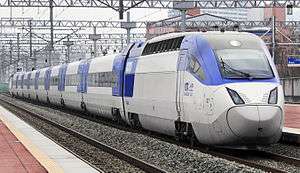
South Korea has a technologically advanced transport network consisting of high-speed railways, highways, bus routes, ferry services, and air routes that criss-cross the country. Korea Expressway Corporation operates the toll highways and service amenities en route.
Korail provides frequent train services to all major South Korean cities. Two rail lines, Gyeongui and Donghae Bukbu Line, to North Korea are now being reconnected. The Korean high-speed rail system, KTX, provides high-speed service along Gyeongbu and Honam Line. Major cities including Seoul, Busan, Incheon, Daegu, Daejeon and Gwangju have urban rapid transit systems.[300] Express bus terminals are available in most cities.[301]
South Korea's largest airport, Incheon International Airport, was completed in 2001. By 2007, it was serving 30 million passengers a year.[302] Other international airports include Gimpo, Busan and Jeju. There are also seven domestic airports, and a large number of heliports.[303]
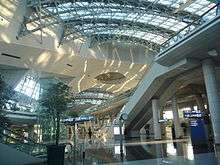
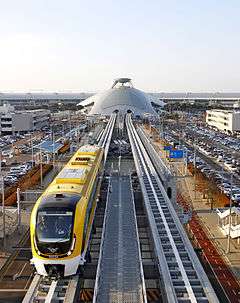
Korean Air, founded in 1962, served 21,640,000 passengers, including 12,490,000 international passengers in 2008.[305] A second carrier, Asiana Airlines, established in 1988, also serves domestic and international traffic. Combined, South Korean airlines serve 297 international routes.[306] Smaller airlines, such as Jeju Air, provide domestic service with lower fares.[307]
South Korea is the world's fifth-largest nuclear power producer and the second-largest in Asia as of 2010.[308] Nuclear power in South Korea supplies 45% of electricity production, and research is very active with investigation into a variety of advanced reactors, including a small modular reactor, a liquid-metal fast/transmutation reactor and a high-temperature hydrogen generation design. Fuel production and waste handling technologies have also been developed locally. It is also a member of the ITER project.[309]
South Korea is an emerging exporter of nuclear reactors, having concluded agreements with the UAE to build and maintain four advanced nuclear reactors,[310] with Jordan for a research nuclear reactor,[311][312] and with Argentina for construction and repair of heavy-water nuclear reactors.[313][314] As of 2010, South Korea and Turkey are in negotiations regarding construction of two nuclear reactors.[315] South Korea is also preparing to bid on construction of a light-water nuclear reactor for Argentina.[314]
South Korea is not allowed to enrich uranium or develop traditional uranium enrichment technology on its own, because of US political pressure,[316] unlike most major nuclear powers such as Japan, Germany, and France, competitors of South Korea in the international nuclear market. This impediment to South Korea's indigenous nuclear industrial undertaking has sparked occasional diplomatic rows between the two allies. While South Korea is successful in exporting its electricity-generating nuclear technology and nuclear reactors, it cannot capitalize on the market for nuclear enrichment facilities and refineries, preventing it from further expanding its export niche. South Korea has sought unique technologies such as pyroprocessing to circumvent these obstacles and seek a more advantageous competition.[317] The US has recently been wary of South Korea's burgeoning nuclear program, which South Korea insists will be for civilian use only.[308]
South Korea is the third highest ranked Asian country in the World Economic Forum's Network Readiness Index (NRI) after Singapore and Hong Kong respectively – an indicator for determining the development level of a country’s information and communication technologies. South Korea ranked number 10 overall in the 2014 NRI ranking, up from 11 in 2013.[318]
Tourism
In 2012, 11.1 million foreign tourists visited South Korea, making it the 20th most visited country in the world,[319] up from 8.5 million in 2010.[320] Due to Hallyu, South Korea welcomed more than 12 million visitors in 2013 with 6 million tourists coming from China alone.[321][322] With rising tourist prospects, especially from foreign countries outside of Asia, the South Korean government has set a target of attracting 20 million foreign tourists a year by 2017.[323] Hallyu's positive effects of the nation's entertainment industry are not limited to within its culture industry, according to a study by the Hyundai Research Institute. The Hyundai Research Institute reported that the Korean Wave has a direct impact in encouraging direct foreign investment back into the country through demand for products, and the tourism industry.[324] Among Asian countries, China was the most receptive, investing 1.4 billion in South Korea, with much of the investment within its service sector, a sevenfold increase from 2001. According to economist, Han Sang-Wan, shown an analysis that a 1 percent increase of exports of Korean cultural content pushes consumer goods exports up 0.083 percent while a 1 percent increase in Korean pop content exports to a country produces a 0.019 percent bump in tourism.[324]
Science and technology
.jpg)
Scientific and technological development in the South Korea at first did not occur largely because of more pressing matters such as the division of Korea and the Korean War that occurred right after its independence. It wasn't until the 1960s under the dictatorship of Park Chung-hee where South Korea's economy rapidly grew from industrialisation and the Chaebol corporations such as Samsung and LG. Ever since the industrialization of South Korea's economy, South Korea has placed its focus on technology-based corporations, which has been supported by infrastructure developments by the government. South Korean corporations Samsung and LG were ranked first and third largest mobile phone companies in the world in the first quarter of 2012, respectively.[325] An estimated 90% of South Koreans own a mobile phone.[326] Aside from placing/receiving calls and text messaging, mobile phones in the country are widely used for watching Digital Multimedia Broadcasting (DMB) or viewing websites.[327] Over one million DMB phones have been sold and the three major wireless communications providers SK Telecom, KT, and LG U+ provide coverage in all major cities and other areas. South Korea has the fastest Internet download speeds in the world, with an average download speed of 25.3 Mbit/s.[328]
South Korea leads the OECD in graduates in science and engineering.[38] The country ranks first among the most innovative countries in the Bloomberg Innovation Index.[42][329] Additionally, South Korea today is known as a Launchpad of a mature mobile market, where developers can reap benefits of a market where very few technology constraints exist. There is a growing trend of inventions of new types of media or apps, utilizing the 4G and 5G internet infrastructure in South Korea. South Korea has today the infrastructures to meet a density of population and culture that has the capability to create strong local particularity.[330]
Cyber security
Following cyberattacks in the first half of 2013, whereby government, news-media, television station, and bank websites were compromised, the national government committed to the training of 5,000 new cybersecurity experts by 2017. The South Korean government blamed its northern counterpart for these attacks, as well as incidents that occurred in 2009, 2011 and 2012, but Pyongyang denies the accusations.[331]
In late September 2013, a computer-security competition jointly sponsored by the defense ministry and the National Intelligence Service was announced. The winners were announced on September 29, 2013 and shared a total prize pool of 80 million won (US$74,000).[331]
Aerospace research

South Korea has sent up 10 satellites from 1992, all using foreign rockets and overseas launch pads, notably Arirang-1 in 1999, and Arirang-2 in 2006 as part of its space partnership with Russia.[332] Arirang-1 was lost in space in 2008, after nine years in service.[333]
In April 2008, Yi So-yeon became the first Korean to fly in space, aboard the Russian Soyuz TMA-12.[334][335]
In June 2009, the first spaceport of South Korea, Naro Space Center, was completed at Goheung, Jeollanam-do.[336] The launch of Naro-1 in August 2009 resulted in a failure.[337] The second attempt in June 2010 was also unsuccessful.[338] However the third launch of the Naro 1 in January 2013 was successful.[339] The government plans to develop Naro-2 by the year 2018.[340]
South Korea's efforts to build an indigenous space launch vehicle is marred because of persistent political pressure of the United States, who had for many decades hindered South Korea's indigenous rocket and missile development programs[341] in fear of their possible connection to clandestine military ballistic missile programs, which Korea many times insisted did not violate the research and development guidelines stipulated by US-Korea agreements on restriction of South Korean rocket technology research and development.[342] South Korea has sought the assistance of foreign countries such as Russia through MTCR commitments to supplement its restricted domestic rocket technology. The two failed KSLV-I launch vehicles were based on the Universal Rocket Module, the first stage of the Russian Angara rocket, combined with a solid-fueled second stage built by South Korea.
Robotics
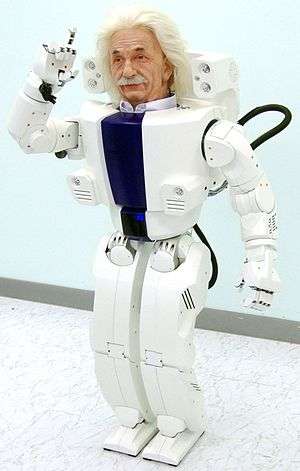
Robotics has been included in the list of main national R&D projects in Korea since 2003.[343] In 2009, the government announced plans to build robot-themed parks in Incheon and Masan with a mix of public and private funding.[344]
In 2005, Korea Advanced Institute of Science and Technology (KAIST) developed the world's second walking humanoid robot, HUBO. A team in the Korea Institute of Industrial Technology developed the first Korean android, EveR-1 in May 2006.[345] EveR-1 has been succeeded by more complex models with improved movement and vision.[346][347]
Plans of creating English-teaching robot assistants to compensate for the shortage of teachers were announced in February 2010, with the robots being deployed to most preschools and kindergartens by 2013.[348] Robotics are also incorporated in the entertainment sector as well; the Korean Robot Game Festival has been held every year since 2004 to promote science and robot technology.[349]
Biotechnology
Since the 1980s, the Korean government has invested in the development of a domestic biotechnology industry, and the sector is projected to grow to $6.5 billion by 2010.[350] The medical sector accounts for a large part of the production, including production of hepatitis vaccines and antibiotics.
Recently, research and development in genetics and cloning has received increasing attention, with the first successful cloning of a dog, Snuppy (in 2005), and the cloning of two females of an endangered species of wolves by the Seoul National University in 2007.[351]
The rapid growth of the industry has resulted in significant voids in regulation of ethics, as was highlighted by the scientific misconduct case involving Hwang Woo-Suk.[352]
Culture
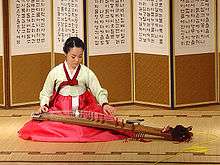
South Korea shares its traditional culture with North Korea, but the two Koreas have developed distinct contemporary forms of culture since the peninsula was divided in 1945. Historically, while the culture of Korea has been heavily influenced by that of neighboring China, it has nevertheless managed to develop a unique cultural identity that is distinct from its larger neighbor.[353] The South Korean Ministry of Culture, Sports and Tourism actively encourages the traditional arts, as well as modern forms, through funding and education programs.[354]
The industrialization and urbanization of South Korea have brought many changes to the way Korean people live. Changing economics and lifestyles have led to a concentration of population in major cities, especially the capital Seoul, with multi-generational households separating into nuclear family living arrangements. A 2014 Euromonitor study found that South Koreans drink the most alcohol on a weekly basis compared to the rest of the world. South Koreans drink 13.7 shots of liquor per week on average and, of the 44 other countries analyzed, Russia, the Philippines, and Thailand follow.[355]
Art

Korean art has been highly influenced by Buddhism and Confucianism, which can be seen in the many traditional paintings, sculptures, ceramics and the performing arts.[356] Korean pottery and porcelain, such as Joseon's baekja and buncheong, and Goryeo's celadon are well known throughout the world.[357] The Korean tea ceremony, pansori, talchum and buchaechum are also notable Korean performing arts.
Post-war modern Korean art started to flourish in the 1960s and 1970s, when South Korean artists took interest in geometrical shapes and intangible subjects. Establishing a harmony between man and nature was also a favorite of this time. Because of social instability, social issues appeared as main subjects in the 1980s. Art was influenced by various international events and exhibits in Korea, and with it brought more diversity.[358] The Olympic Sculpture Garden in 1988, the transposition of the 1993 edition of the Whitney Biennial to Seoul,[359] the creation of the Gwangju Biennale[360] and the Korean Pavilion at the Venice Biennale in 1995[361] were notable events.
Architecture
Because of South Korea's tumultuous history, construction and destruction has been repeated endlessly, resulting in an interesting melange of architectural styles and designs.[362]
Korean traditional architecture is characterized by its harmony with nature. Ancient architects adopted the bracket system characterized by thatched roofs and heated floors called ondol.[363] People of the upper classes built bigger houses with elegantly curved tiled roofs with lifting eaves. Traditional architecture can be seen in the palaces and temples, preserved old houses called hanok,[364] and special sites like Hahoe Folk Village, Yangdong Village of Gyeongju and Korean Folk Village. Traditional architecture may also be seen at the nine UNESCO World Heritage Sites in South Korea.[365]
Western architecture was first introduced to Korea at the end of the 19th century. Churches, offices for foreign legislation, schools and university buildings were built in new styles. With the annexation of Korea by Japan in 1910 the colonial regime intervened in Korea's architectural heritage, and Japanese-style modern architecture was imposed. The anti-Japanese sentiment, and the Korean War, led to the destruction of most buildings constructed during that time.[366]
Korean architecture entered a new phase of development during the post-Korean War reconstruction, incorporating modern architectural trends and styles. Stimulated by the economic growth in the 1970s and 1980s, active redevelopment saw new horizons in architectural design. In the aftermath of the 1988 Seoul Olympics, South Korea has witnessed a wide variation of styles in its architectural landscape due, in large part, to the opening up of the market to foreign architects.[367] Contemporary architectural efforts have been constantly trying to balance the traditional philosophy of "harmony with nature" and the fast-paced urbanization that the country has been going through in recent years.[368]
Cuisine
Korean cuisine, hanguk yori (한국요리; 韓國料理), or hansik (한식; 韓食), has evolved through centuries of social and political change. Ingredients and dishes vary by province. There are many significant regional dishes that have proliferated in different variations across the country in the present day. The Korean royal court cuisine once brought all of the unique regional specialties together for the royal family. Meals consumed both by the royal family and ordinary Korean citizens have been regulated by a unique culture of etiquette.
Korean cuisine is largely based on rice, noodles, tofu, vegetables, fish and meats. Traditional Korean meals are noted for the number of side dishes, banchan (반찬), which accompany steam-cooked short-grain rice. Every meal is accompanied by numerous banchan. Kimchi (김치), a fermented, usually spicy vegetable dish is commonly served at every meal and is one of the best known Korean dishes. Korean cuisine usually involves heavy seasoning with sesame oil, doenjang (된장), a type of fermented soybean paste, soy sauce, salt, garlic, ginger, and gochujang (고추장), a hot pepper paste. Other well-known dishes are Bulgogi (불고기), grilled marinated beef, Gimbap (김밥), and Tteokbokki (떡볶이), a spicy snack consisting of rice cake seasoned with gochujang or a spicy chili paste.
Soups are also a common part of a Korean meal and are served as part of the main course rather than at the beginning or the end of the meal. Soups known as guk (국) are often made with meats, shellfish and vegetables. Similar to guk, tang (탕; 湯) has less water, and is more often served in restaurants. Another type is jjigae (찌개), a stew that is typically heavily seasoned with chili pepper and served boiling hot.
South Korean snack companies, such as Lotte, are famous for making a wide range of Korean or other Asian-inspired snacks. One example is Pepero, a snack similar to Pocky, which originates from Japan. Pepero is manufactured by Lotte Confectionery.
Popular Korean alcoholic beverages include Soju, Makgeolli and Bokbunja ju.
Korea is unique among Asian countries in its use of metal chopsticks. Metal chopsticks have been discovered in Goguryeo archaeological sites.[369]
Entertainment
In addition to domestic consumption, South Korean entertainment including televised dramas, films, and popular music has generated significant financial revenues for the South Korean economy. The cultural phenomenon known as Hallyu or the "Korean Wave", has swept many countries across Asia making South Korea a major soft power as an exporter of popular culture and entertainment, rivaling many Western nations such as the United States and the United Kingdom.[370]
Until the 1990s, trot and ballads dominated South Korean popular music. The emergence of the rap group Seo Taiji and Boys in 1992 marked a turning point for South Korean popular music, also known as K-pop, as the group incorporated elements of popular musical genres from the West such as hip hop, rhythm and blues, electronic dance, jazz, reggae, funk, and rock into its music.[371] Hip hop, rhythm and blues, rock, electronic dance and ballad oriented acts have become dominant in the South Korean popular music scene, though trot is still enjoyed among older South Koreans. K-pop stars and groups are well known across Asia and have found international fame making millions of dollars in export revenue. Many K-pop acts have been able secure a strong overseas following using online social media platforms such as YouTube. South Korean music artist PSY became an international sensation when his song "Gangnam Style" topped global music charts in 2012.
Since the success of the film Shiri in 1999, the Korean film industry has begun to gain recognition internationally. Domestic film has a dominant share of the market, partly because of the existence of screen quotas requiring cinemas to show Korean films at least 73 days a year.[372]
South Korean television shows have become popular outside of Korea. Many dramas tend to have a romantic focus, such as Princess Hours, You're Beautiful, Playful Kiss, My Name is Kim Sam Soon, Boys Over Flowers, Winter Sonata, Autumn in My Heart, Full House, City Hunter, All About Eve, Secret Garden, I Can Hear Your Voice, Master's Sun, My Love from the Star and Descendants of the Sun. Historical dramas have included Faith, Dae Jang Geum, The Legend, Dong Yi, Moon Embracing the Sun, and Sungkyunkwan Scandal.[373]
Holidays
There are many official public holidays in South Korea. Korean New Year's Day, or "Seollal", is celebrated on the first day of the Korean lunar calendar. Korean Independence Day falls on March 1, and commemorates the March 1 Movement of 1919. Memorial Day is celebrated on June 6, and its purpose is to honor the men and women who died in South Korea's independence movement. Constitution Day is on July 17, and it celebrates the promulgation of Constitution of the Republic of Korea. Liberation Day, on August 15, celebrates Korea's liberation from the Empire of Japan in 1945. Every 15th day of the 8th lunar month, Koreans celebrate the Midautumn Festival, in which Koreans visit their ancestral hometowns and eat a variety of traditional Korean foods. On October 1, Armed Forces day is celebrated, honoring the military forces of South Korea. October 3 is National Foundation Day. Hangul Day, on October 9 commemorates the invention of hangul, the native alphabet of the Korean language. There are also unofficial holidays celebrated in Korea, such as Pepero Day, a day to celebrate the Korean snack of Pepero.
Sports
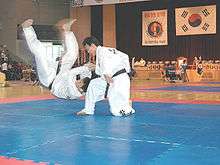
The martial art taekwondo originated in Korea. In the 1950s and 1960s, modern rules were standardized, with taekwondo becoming an official Olympic sport in 2000.[374] Other Korean martial arts include taekkyeon, hapkido, Tang Soo Do, Kuk Sool Won, kumdo and subak.[375]
Football and baseball have traditionally been regarded as the most popular sports in Korea.[376] Recent polling indicates that a majority, 41% of South Korean sports fans continue to self-identify as football fans, with baseball ranked 2nd at 25% of respondents. However, the polling did not indicate the extent to which respondents follow both sports.[377] The national football team became the first team in the Asian Football Confederation to reach the FIFA World Cup semi-finals in the 2002 FIFA World Cup, jointly hosted by South Korea and Japan. The Korea Republic national team (as it is known) has qualified for every World Cup since Mexico 1986, and has broken out of the group stage twice: first in 2002, and again in 2010, when it was defeated by eventual semi-finalist Uruguay in the Round of 16. At the 2012 Summer Olympics, South Korea won the Bronze Medal for football.
Baseball was first introduced to Korea in 1905 and has since become increasingly popular, with some sources claiming it has surpassed football as the most popular sport in the country.[378][379][380] Recent years have been characterized by increasing attendance and ticket prices for professional baseball games.[381][382] The Korea Professional Baseball league, a 10-team circuit, was established in 1982. The South Korea national team finished third in the 2006 World Baseball Classic and second in the 2009 tournament. The team's 2009 final game against Japan was widely watched in Korea, with a large screen at Gwanghwamun crossing in Seoul broadcasting the game live.[383] In the 2008 Summer Olympics, South Korea won the gold medal in baseball.[384] Also in 1982, at the Baseball Worldcup, Korea won the gold medal. At the 2010 Asian Games, the Korean National Baseball team won the gold medal. Several Korean players have gone on to play in Major League Baseball.
Basketball is a popular sport in the country as well. South Korea has traditionally had one of the top basketball teams in Asia and one of the continent's strongest basketball divisions. Seoul hosted the 1967 and 1995 Asian Basketball Championship. The Korea national basketball team has won a record number of 23 medals at the event to date.[385]
South Korea hosted the Asian Games in 1986 (Seoul), 2002 (Busan) and 2014 (Incheon). It also hosted the Winter Universiade in 1997, the Asian Winter Games in 1999 and the Summer Universiade in 2003, 2015. In 1988, South Korea hosted the Summer Olympics in Seoul, coming fourth with 12 gold medals, 10 silver medals and 11 bronze medals. South Korea regularly performs well in archery, shooting, table tennis, badminton, short track speed skating, handball, hockey, freestyle wrestling, Greco-Roman wrestling, baseball, judo, taekwondo, speed skating, figure Skating, and weightlifting. The Seoul Olympic Museum is a museum in Seoul, South Korea, dedicated to the 1988 Summer Olympics. On July 6, 2011 Pyeongchang was chosen by the IOC to host the 2018 Winter Olympics.
South Korea has won more medals in the Winter Olympics than any other Asian country with a total of 45 medals (23 gold, 14 silver, and 8 bronze). At the 2010 Winter Olympics, South Korea ranked fifth in the overall medal rankings. South Korea is especially strong in short track speed skating. However, speed skating and figure skating are very popular, too, and ice hockey is an emerging sport with Anyang Halla winning their first ever Asia League Ice Hockey title in March 2010.[386]
Seoul hosted a professional triathlon race, which is part of the International Triathlon Union (ITU) World Championship Series in May 2010.[387] In 2011, the South Korean city of Daegu hosted the 2011 IAAF World Championships in Athletics.[388]
In October 2010, South Korea hosted its first Formula One race at the Korea International Circuit in Yeongam, about 400 kilometres (250 mi) south of Seoul.[389] The Korean Grand Prix was held from 2010 to 2013, but was not placed on the 2014 F1 calendar.[390]
Domestic horse racing events are also followed by South Koreans and Seoul Race Park in Gwacheon, Gyeonggi-do is located closest to Seoul out of the country's three tracks.[391]
Competitive video gaming, also called eSports (sometimes written e-Sports), has become more popular South Korea in recent years, particularly among young people.[392] The two most popular games are League of Legends and StarCraft. The gaming scene of South Korea is managed by the Korean e-Sports Association (KeSPA for short) and has become something of a career for many players. They can make a living out of their activity and top players can even make a significant amount of money with some high end Starcraft II players ending up making six figure salaries.
Korea Professional Sports League
|
Baseball
|
Basketball
|
|
|
International Championship Host
|
|
|
|
|
|
|
|
|
|
Notes
See also
- Index of South Korea-related articles
- International rankings of South Korea
- List of companies of South Korea
- List of South Korean tourist attractions
- Outline of South Korea
References
- ↑ "A New Way of Seeing Country Social Responsibility" (PDF). Faculty of Philosophy and Social-Political Sciences. Alexandru Ioan Cuza University: 6. Archived from the original (PDF) on September 25, 2013. Retrieved January 16, 2014.
- ↑ No official data regarding ethnicity is collected by the South Korean government. At the end of 2015, approximately 4% of the population had a foreign nationality.
- ↑ 지표상세. Index.go.kr (July 19, 2016). Retrieved on 2016-10-05.
- 1 2 3 4 "Population Projections for Provinces (2013~2040)" (PDF). Statistics Korea. April 16, 2016. Retrieved May 20, 2016.
- 1 2 3 "Major Indicators of Korea". Korean Statistical Information Service. Retrieved September 9, 2016.
- 1 2 3 4 "South Korea". International Monetary Fund. 2016. Retrieved April 2016. Check date values in:
|access-date=(help) - ↑ "Country Comparison :: Distribution of family income – Gini index". The World Factbook. Langley: Central Intelligence Agency. Retrieved November 11, 2013.
- ↑ "2015 Human Development Report" (PDF). United Nations Development Programme. 2015. Retrieved December 14, 2015.
- 1 2
 This article incorporates public domain material from the CIA World Factbook website https://www.cia.gov/library/publications/the-world-factbook/index.html.
This article incorporates public domain material from the CIA World Factbook website https://www.cia.gov/library/publications/the-world-factbook/index.html. - ↑ 지표상세. Index.go.kr. July 24, 2015. Retrieved June 20, 2016.
- ↑ [수도권]‘응팔 아파트’ 만들기 서울시의 이색 도전 : 뉴스 : 동아닷컴. News.donga.com (January 7, 2016). Retrieved on June 20, 2016.
- ↑ "Current population of the Seoul National Capital Area". Statistics Korea.
- ↑ Institute for Urban Strategies, The Mori Memorials Foundation (2015). Global Power City Index 2015. Retrieved March 2, 2016
- ↑ Global Metro Monitor |Brookings Institution. Brookings.edu (January 22, 2015). Retrieved on June 20, 2016.
- ↑ https://www.arcadis.com/en/global/our-perspectives/sustainable-cities-index-2016/comparing-cities/
- ↑ Chong Pil Choe, Martin T. Bale, "Current Perspectives on Settlement, Subsistence, and Cultivation in Prehistoric Korea", (2002), Arctic Anthropology, 39: 1–2, pp. 95–121.
- ↑ Roberts, John Morris; Westad, Odd Arne. The History of the World. Oxford University Press. p. 443. ISBN 9780199936762. Retrieved July 15, 2016.
- ↑ Gardner, Hall. Averting Global War: Regional Challenges, Overextension, and Options for American Strategy. Palgrave Macmillan. pp. 158–159. ISBN 9780230608733. Retrieved July 15, 2016.
- ↑ Laet, Sigfried J. de. History of Humanity: From the seventh to the sixteenth century. UNESCO. p. 1133. ISBN 9789231028137. Retrieved 8 November 2016.
- ↑ Walker, Hugh Dyson. East Asia: A New History. AuthorHouse. pp. 6–7. ISBN 9781477265178. Retrieved 19 November 2016.
- ↑ Kotkin, Stephen; Wolff, David. Rediscovering Russia in Asia: Siberia and the Russian Far East: Siberia and the Russian Far East. Routledge. ISBN 9781317461296. Retrieved July 15, 2016.
- ↑ Tudor, Daniel. Korea: The Impossible Country: The Impossible Country. Tuttle Publishing. ISBN 9781462910229. Retrieved July 15, 2016.
- ↑ Kim, Jinwung (2012). A History of Korea: From "Land of the Morning Calm" to States in Conflict. Bloomington, Indiana: Indiana University Press. p. 35. ISBN 0253000785. Retrieved July 15, 2016.
- ↑ "Behind the Myth: The Many Invasions of Korea". Gwangju News Online.
- 1 2 Koerner, E. F. K.; Asher, R. E. Concise History of the Language Sciences: From the Sumerians to the Cognitivists. Elsevier. p. 54. ISBN 9781483297545. Retrieved 8 November 2016.
- 1 2 "Republic of Korea". worldbank.org.
- ↑ What do you do when you reach the top?. Economist.com (November 12, 2011). Retrieved on June 20, 2016.
- ↑ As percentage of government budget surplus.
- ↑ As rated by the three major credit rating agencies of S&P, Fitch and Moody's.
- ↑ http://m.post.naver.com/viewer/postView.nhn?volumeNo=3524965&memberNo=9325654&vType=VERTICAL
- ↑ Korean cultural export success rooted in freedom and democracy, industry insiders say. Scmp.com. Retrieved on June 20, 2016.
- ↑ "South Korea's K-pop craze lures fans and makes profits". BBC News. April 26, 2011.
- ↑ Green growth in action: Korea. OECD. Retrieved on June 20, 2016.
- ↑ https://www.passportindex.org/byWelcomingRank.php
- ↑ Group Grievance indicator – Fragile States Index. Fsi.fundforpeace.org. Retrieved on June 20, 2016.
- ↑ Crime Index by Country 2016. Numbeo.com. Retrieved on June 20, 2016.
- ↑ Lu, Lisa Du lisadont Wei (September 29, 2016). "U.S. Health-Care System Ranks as One of the Least-Efficient" – via www.bloomberg.com.
- 1 2 "These are the 10 smartest countries in the world when it comes to science". Business Insider. 4 December 2015. Retrieved 26 October 2016.
- ↑ http://www.youthindex.org/reports/globalyouthwellbeingindex.pdf
- ↑ Samsung remains smartphone leader as Apple struggles. CNET (April 27, 2016). Retrieved on June 20, 2016.
- ↑ • LCD TV market share manufacturers worldwide 2008–2015 |Statistic. Statista.com. Retrieved on June 20, 2016.
- 1 2 "The Bloomberg Innovation Index". Bloomberg.
- ↑ Fels, Enrico (2017). Shifting Power in Asia-Pacific? The Rise of China, Sino-US Competition and Regional Middle Power Allegiance. Springer. pp. 567–635. ISBN 978-3-319-45689-8. Retrieved 2016-11-25.
- ↑ UN E-Government Survey 2014. Unpan3.un.org. Retrieved on June 20, 2016.
- ↑ Ahonen, Tomi; O'Reilly, Jim (2007). Digital Korea. futuretext. p. 173. ISBN 978-0-9556069-0-8.
- 1 2 Rossabi, Morris. China Among Equals: The Middle Kingdom and Its Neighbors, 10th-14th Centuries. University of California Press. p. 323. ISBN 9780520045620. Retrieved 8 November 2016.
- 1 2 Yi, Ki-baek. A New History of Korea. Harvard University Press. p. 103. ISBN 9780674615762. Retrieved 8 November 2016.
- 1 2 Kim, Djun Kil. The History of Korea. ABC-CLIO. p. 57. ISBN 9780313038532. Retrieved 8 November 2016.
- 1 2 Grayson, James H. Korea - A Religious History. Routledge. p. 79. ISBN 9781136869259. Retrieved 8 November 2016.
- ↑ Yunn, Seung-Yong (1996), "Muslims earlier contact with Korea", Religious culture of Korea, Hollym International, p. 99
- 1 2 3 Korea原名Corea? 美國改的名.. United Daily News website. July 5, 2008. Retrieved March 28, 2014.
- ↑ Barbara Demick (September 15, 2003). "A 'C' Change in Spelling Sought for the Koreas". Los Angeles Times. Retrieved March 28, 2016.
- ↑ "Korea vs Corea". Monster Island. Archived from the original on November 1, 2009. Retrieved March 28, 2016.
- 1 2 "Korean Classics : Asian Collections: An Illustrated Guide (Library of Congress – Asian Division)". Library of Congress. United States Congress. Retrieved August 19, 2016.
- 1 2 "Gutenberg Bible". British Library. The British Library Board. Retrieved August 19, 2016.
- 1 2 "Korea, 1000–1400 A.D. | Chronology | Heilbrunn Timeline of Art History | The Metropolitan Museum of Art". The Met’s Heilbrunn Timeline of Art History. The Metropolitan Museum of Art. Retrieved August 19, 2016.
- 1 2 "Movable type – Oxford Reference". Oxford Reference. Oxford University Press. doi:10.1093/oi/authority.20110803100213284. Retrieved August 19, 2016.
- 1 2 Ebrey, Patricia Buckley; Walthall, Anne. East Asia: A Cultural, Social, and Political History. Cengage Learning. ISBN 1285528670. Retrieved August 19, 2016.
- ↑ "Korea's History". Asian Shravan. Retrieved February 17, 2009.
- 1 2
- Seth, Michael J. (2010). A History of Korea: From Antiquity to the Present. Rowman & Littlefield Publishers. p. 443. ISBN 978-0-7425-6717-7.
- "An extreme manifestation of nationalism and the family cult was the revival of interest in Tangun, the mythical founder of the first Korean state... Most textbooks and professional historians, however, treat him as a myth."
- Stark, Miriam T. (2008). Archaeology of Asia. John Wiley & Sons. p. 49. ISBN 978-1-4051-5303-4.
- "Although Kija may have truly existed as a historical figure, Tangun is more problematical."
- Schmid, Andre (2013). Korea Between Empires. Columbia University Press. p. 270. ISBN 978-0-231-50630-4.
- "Most [Korean historians] treat the [Tangun] myth as a later creation."
- Peterson, Mark (2009). Brief History of Korea. Infobase Publishing. p. 5. ISBN 978-1-4381-2738-5.
- "The Tangun myth became more popular with groups that wanted Korea to be independent; the Kija myth was more useful to those who wanted to show that Korea had a strong affinity to China."
- Hulbert, H. B. (2014). The History of Korea. Routledge. p. 73. ISBN 978-1-317-84941-4.
- "If a choice is to be made between them, one is faced with the fact that the Tangun, with his supernatural origin, is more clearly a mythological figure than Kija."
- ↑ Hwang, Kyung-moon (2010). A History of Korea, An Episodic Narrative. Palgrave Macmillan. p. 4. ISBN 9780230364530.
- ↑ Early Korea. Shsu.edu. Retrieved on April 17, 2015.
- ↑ Yi, Ki-baek. A New History of Korea. Harvard University Press. pp. 23–24. ISBN 9780674615762. Retrieved 21 November 2016.
- ↑ Walker, Hugh Dyson. East Asia: A New History. AuthorHouse. p. 104. ISBN 9781477265161. Retrieved 21 November 2016.
- ↑ Yi, Hyŏn-hŭi; Pak, Sŏng-su; Yun, Nae-hyŏn. New history of Korea. Jimoondang. p. 201. ISBN 9788988095850.
He launched a military expedition to expand his territory, opening the golden age of Goguryeo.
- ↑ Hall, John Whitney. The Cambridge History of Japan. Cambridge University Press. p. 362. ISBN 9780521223522. Retrieved July 29, 2016.
- ↑ Embree, Ainslie Thomas. Encyclopedia of Asian history. Scribner. p. 324. ISBN 9780684188997. Retrieved July 29, 2016.
- ↑ Cohen, Warren I. East Asia at the Center: Four Thousand Years of Engagement with the World. Columbia University Press. p. 50. ISBN 9780231502511. Retrieved July 29, 2016.
- ↑ Kim, Jinwung. A History of Korea: From "Land of the Morning Calm" to States in Conflict. Indiana University Press. p. 35. ISBN 0253000785. Retrieved 11 October 2016.
- ↑ "Kings and Queens of Korea". KBS World Radio. Korea Communications Commission. Retrieved August 26, 2016.
- ↑ Walker, Hugh Dyson. East Asia: A New History. AuthorHouse. p. 161. ISBN 9781477265178. Retrieved 8 November 2016.
- ↑ White, Matthew. Atrocities: The 100 Deadliest Episodes in Human History. W. W. Norton & Company. p. 78. ISBN 9780393081923. Retrieved 8 November 2016.
- ↑ Grant, Reg G. 1001 Battles That Changed the Course of World History. Universe Pub. p. 104. ISBN 9780789322333. Retrieved 8 November 2016.
- ↑ Bedeski, Robert. Human Security and the Chinese State: Historical Transformations and the Modern Quest for Sovereignty. Routledge. p. 90. ISBN 9781134125975. Retrieved 8 November 2016.
- ↑ Yi, Ki-baek. A New History of Korea. Harvard University Press. p. 47. ISBN 9780674615762. Retrieved July 29, 2016.
Koguryŏ was the first to open hostilities, with a bold assault across the Liao River against Liao-hsi, in 598. The Sui emperor, Wen Ti, launched a retaliatory attack on Koguryŏ but met with reverses and turned back in mid-course. Yang Ti, the next Sui emperor, proceeded in 612 to mount an invasion of unprecedented magnitude, marshalling a huge force said to number over a million men. And when his armies failed to take Liao-tung Fortress (modern Liao-yang), the anchor of Koguryŏ's first line of defense, he had a nearly a third of his forces, some 300,000 strong, break off the battle there and strike directly at the Koguryŏ capital of P'yŏngyang. But the Sui army was lured into a trap by the famed Koguryŏ commander Ŭlchi Mundŏk, and suffered a calamitous defeat at the Salsu (Ch'ŏngch'ŏn) River. It is said that only 2,700 of the 300,000 Sui soldiers who had crossed the Yalu survived to find their way back, and the Sui emperor now lifted the siege of Liao-tung Fortress and withdrew his forces to China proper. Yang Ti continued to send his armies against Koguryŏ but again without success, and before long his war-weakened empire crumbled.
- ↑ Nahm, Andrew C. (2005). A Panorama of 5000 Years: Korean History (Second revised ed.). Seoul: Hollym International Corporation. p. 18. ISBN 093087868X.
China, which had been split into many states since the early 3rd century, was reunified by the Sui dynasty at the end of the 6th century. Soon after that, Sui China mobilized a large number of troops and launched war against Koguryŏ. However, the people of Koguryŏ were united and they were able to repel the Chinese aggressors. In 612, Sui troops invaded Korea again, but Koguryŏ forces fought bravely and destroyed Sui troops everywhere. General Ŭlchi Mundŏk of Koguryŏ completely wiped out some 300,000 Sui troops which came across the Yalu River in the battles near the Salsu River (now Ch'ŏngch'ŏn River) with his ingenious military tactics. Only 2,700 Sui troops were able to flee from Korea. The Sui dynasty, which wasted so much energy and manpower in aggressive wars against Koguryŏ, fell in 618.
- ↑ Ebrey, Patricia Buckley; Walthall, Anne; Palais, James B. East Asia: A Cultural, Social, and Political History. Houghton Mifflin. p. 123. ISBN 9780618133840. Retrieved September 12, 2016.
- ↑ Kitagawa, Joseph. The Religious Traditions of Asia: Religion, History, and Culture. Routledge. p. 348. ISBN 9781136875908. Retrieved July 29, 2016.
- ↑ Ebrey, Patricia Buckley; Walthall, Anne; Palais, James B. East Asia: A Cultural, Social, and Political History, Volume I: To 1800. Cengage Learning. p. 104. ISBN 1111808155. Retrieved September 12, 2016.
- ↑ A Brief History of Korea. Ewha Womans University Press. pp. 29–30. ISBN 9788973006199. Retrieved 21 November 2016.
- ↑ Yu, Chai-Shin. The New History of Korean Civilization. iUniverse. p. 27. ISBN 9781462055593. Retrieved 21 November 2016.
- ↑ Kim, Jinwung. A History of Korea: From "Land of the Morning Calm" to States in Conflict. Indiana University Press. pp. 44–45. ISBN 0253000246. Retrieved September 12, 2016.
- ↑ Wells, Kenneth M. Korea: Outline of a Civilisation. BRILL. pp. 18–19. ISBN 9789004300057. Retrieved September 12, 2016.
- ↑ DuBois, Jill. Korea. Marshall Cavendish. p. 22. ISBN 9780761417866. Retrieved July 29, 2016.
- ↑ Randel, Don Michael. The Harvard Dictionary of Music. Harvard University Press. p. 273. ISBN 9780674011632. Retrieved July 29, 2016.
- ↑ Hopfner, Jonathan. Moon Living Abroad in South Korea. Avalon Travel. p. 21. ISBN 9781612386324. Retrieved July 29, 2016.
- ↑ Kim, Djun Kil. The History of Korea. ABC-CLIO. p. 47. ISBN 9780313038532. Retrieved September 30, 2016.
- ↑ Kitagawa, Joseph. The Religious Traditions of Asia: Religion, History, and Culture. Routledge. p. 348. ISBN 9781136875908. Retrieved July 21, 2016.
- ↑ Gernet, Jacques. A History of Chinese Civilization. Cambridge University Press. p. 291. ISBN 9780521497817. Retrieved July 21, 2016.
- ↑ Reischauer, Edwin Oldfather. Ennins Travels in Tang China. John Wiley & Sons Canada, Limited. pp. 276–283. ISBN 9780471070535. Retrieved July 21, 2016.
From what Ennin tells us, it seems that commerce between East China, Korea and Japan was, for the most part, in the hands of men from Silla. Here in the relatively dangerous waters on the eastern fringes of the world, they performed the same functions as did the traders of the placid Mediterranean on the western fringes. This is a historical fact of considerable significance but one which has received virtually no attention in the standard historical compilations of that period or in the modern books based on these sources. . . . While there were limits to the influence of the Koreans along the eastern coast of China, there can be no doubt of their dominance over the waters off these shores. . . . The days of Korean maritime dominance in the Far East actually were numbered, but in Ennin's time the men of Silla were still the masters of the seas in their part of the world.
- ↑ Kim, Djun Kil. The History of Korea, 2nd Edition. ABC-CLIO. p. 3. ISBN 9781610695824. Retrieved July 21, 2016.
- ↑ Seth, Michael J. A Concise History of Korea: From the Neolithic Period Through the Nineteenth Century. Rowman & Littlefield. p. 65. ISBN 9780742540057. Retrieved July 21, 2016.
- ↑ MacGregor, Neil. A History of the World in 100 Objects. Penguin UK. ISBN 9780141966830. Retrieved September 30, 2016.
- ↑ Chŏng, Yang-mo; Smith, Judith G.; Metropolitan Museum of Art (New York, N.Y.). Arts of Korea. Metropolitan Museum of Art. p. 230. ISBN 9780870998508. Retrieved September 30, 2016.
- ↑ International, Rotary. The Rotarian. Rotary International. p. 28. Retrieved September 30, 2016.
- ↑ Ross, Alan. After Pusan. Faber & Faber. ISBN 9780571299355. Retrieved September 30, 2016.
- ↑ Mason, David A. "Gyeongju, Korea's treasure house". Korea.net. Korean Culture and Information Service (KOCIS). Retrieved September 30, 2016.
- ↑ Adams, Edward Ben. Koreaʾs pottery heritage. Seoul International Pub. House. p. 53. Retrieved September 30, 2016.
- ↑ Mun, Chanju; Green, Ronald S. Buddhist Exploration of Peace and Justice. Blue Pine Books. p. 147. ISBN 9780977755301. Retrieved July 29, 2016.
- ↑ McIntire, Suzanne; Burns, William E. Speeches in World History. Infobase Publishing. p. 87. ISBN 9781438126807. Retrieved July 29, 2016.
- ↑ Jr, Robert E. Buswell; Jr, Donald S. Lopez. The Princeton Dictionary of Buddhism. Princeton University Press. p. 187. ISBN 9781400848058. Retrieved July 29, 2016.
- ↑ Poceski, Mario. Ordinary Mind as the Way: The Hongzhou School and the Growth of Chan Buddhism. Oxford University Press. p. 24. ISBN 9780198043201. Retrieved July 29, 2016.
- ↑ Wu, Jiang; Chia, Lucille. Spreading Buddha's Word in East Asia: The Formation and Transformation of the Chinese Buddhist Canon. Columbia University Press. p. 155. ISBN 9780231540193. Retrieved July 29, 2016.
- ↑ Wright, Dale S. The Zen Canon: Understanding the Classic Texts. Oxford University Press. ISBN 9780199882182. Retrieved July 29, 2016.
- ↑ Su-il, Jeong. The Silk Road Encyclopedia. Seoul Selection. ISBN 9781624120763. Retrieved July 29, 2016.
- ↑ Nikaido, Yoshihiro. Asian Folk Religion and Cultural Interaction. Vandenhoeck & Ruprecht. p. 137. ISBN 9783847004851. Retrieved July 29, 2016.
- ↑ Leffman, David; Lewis, Simon; Atiyah, Jeremy. China. Rough Guides. p. 519. ISBN 9781843530190. Retrieved July 29, 2016.
- ↑ Leffman, David. The Rough Guide to China. Penguin. ISBN 9780241010372. Retrieved July 29, 2016.
- ↑ DK Eyewitness Travel Guide: China. Penguin. p. 240. ISBN 9781465455673. Retrieved July 29, 2016.
- ↑ 박, 종기. 고려사의 재발견: 한반도 역사상 가장 개방적이고 역동적인 500년 고려 역사를 만나다 (in Korean). 휴머니스트. ISBN 9788958629023. Retrieved 27 October 2016.
- ↑ Ryu, Howard Jisoo. Orderly Korea Unification: With the Guarantee of Stability in East Asia. Xlibris Corporation. p. 145. ISBN 9781462803323. Retrieved 18 July 2016.
- ↑ Lee, Ki-Baik (1984). A New History of Korea. Cambridge, Massachusetts: Harvard University Press. p. 103. ISBN 067461576X.
When Parhae perished at the hands of the Khitan around this same time, much of its ruling class, who were of Koguryŏ descent, fled to Koryŏ. Wang Kŏn warmly welcomed them and generously gave them land. Along with bestowing the name Wang Kye ("Successor of the Royal Wang") on the Parhae crown prince, Tae Kwang-hyŏn, Wang Kŏn entered his name in the royal household register, thus clearly conveying the idea that they belonged to the same lineage, and also had rituals performed in honor of his progenitor. Thus Koryŏ achieved a true national unification that embraced not only the Later Three Kingdoms but even survivors of Koguryŏ lineage from the Parhae kingdom.
- ↑ "World Treasures: Beginnings". Library of Congress. United States Congress. Retrieved July 15, 2016.
- ↑ "Digital Jikji". Digital Jikji. Retrieved April 25, 2010.
- ↑ Bulliet, Richard; Crossley, Pamela; Headrick, Daniel; Hirsch, Steven; Johnson, Lyman. The Earth and Its Peoples, Brief: A Global History. Cengage Learning. p. 264. ISBN 9781285445519. Retrieved September 12, 2016.
- ↑ Cohen, Warren I. East Asia at the Center: Four Thousand Years of Engagement with the World. Columbia University Press. p. 107. ISBN 9780231502511. Retrieved September 12, 2016.
- ↑ Lee, Kenneth B. Korea and East Asia: The Story of a Phoenix. Greenwood Publishing Group. p. 61. ISBN 9780275958237. Retrieved July 28, 2016.
- ↑ Bowman, John. Columbia Chronologies of Asian History and Culture. Columbia University Press. p. 202. ISBN 9780231500043. Retrieved August 1, 2016.
- 1 2 Lee, Kenneth B. Korea and East Asia: The Story of a Phoenix. Greenwood Publishing Group. p. 72. ISBN 9780275958237. Retrieved 12 November 2016.
- ↑ Currie, Lorenzo. Through the Eyes of the Pack. Xlibris Corporation. p. 181. ISBN 9781493145164. Retrieved July 28, 2016.
- ↑ Yi, Ki-baek. A New History of Korea. Harvard University Press. p. 165. ISBN 9780674615762. Retrieved 19 November 2016.
- ↑ Selin, Helaine. Encyclopaedia of the History of Science, Technology, and Medicine in Non-Westen Cultures. Springer Science & Business Media. pp. 505–506. ISBN 9789401714167. Retrieved July 27, 2016.
- ↑ Haralambous, Yannis; Horne, P. Scott. Fonts & Encodings. "O'Reilly Media, Inc.". p. 155. ISBN 9780596102425. Retrieved 8 November 2016.
- ↑ Lee, Kenneth B. Korea and East Asia: The Story of a Phoenix. Greenwood Publishing Group. p. 86. ISBN 9780275958237. Retrieved July 27, 2016.
- ↑ Turnbull, Stephen (Nov 20, 2012). The Samurai Invasion of Korea 1592–98. Osprey Publishing. p. 17. Retrieved March 25, 2015. "His naval victories were to prove decisive in the Japanese defeat, although Yi was to die during his final battle in 1598."
- ↑ Perez, Louis (2013). Japan At War: An Encyclopedia. Santa Barbara, California: ABC-CLIO. p. 140."Just as a complete Japanese victory appeared imminent, Admiral Yi entered the war and quickly turned the tide."
- ↑ Perez, Louis (2013). Japan At War: An Encyclopedia. Santa Barbara, California: ABC-CLIO. pp. 140–141."Yi's successes gave Korea complete control of the sea lanes around the peninsula, and the Korean navy was able to intercept most of the supplies and communications between Japan and Korea"
- ↑ Elisonas, Jurgis. "The inseparable trinity: Japan's relations with China and Korea." The Cambridge History of Japan. Vol. 4. Ed. John Whitney Hall. Cambridge: Cambridge UP, 1991. pp. 278
- ↑ Lee, Ki-baik. A New History of Korea. Trans. Edward W. Wagner and Edward J. Schultz. Seoul: Ilchokak, 1984. pp. 212
- ↑ 신형식. A Brief History of Korea. Ewha Womans University Press. ISBN 9788973006199. Retrieved 8 November 2016.
- ↑ Beirne, Paul. Su-un and His World of Symbols: The Founder of Korea's First Indigenous Religion. Routledge. ISBN 9781317047490. Retrieved 8 November 2016.
- ↑ "195 (III) The problem of the independence of Korea", December 12, 1948, Resolutions Adopted by the General Assembly During its Third Session, p. 25.
- ↑ Bethany Lacina and Nils Petter Gleditsch, Monitoring Trends in Global Combat: A New Dataset of Battle Deaths, European Journal of Population (2005) 21: 145–166.
- ↑ "Kim Dae-jung: Dedicated to reconciliation". CNN. June 14, 2001. Archived from the original on September 22, 2006. Retrieved September 22, 2006.
- ↑ Flashback: The Kwangju massacre, May 17, 2000.
- ↑ "20 years later, father still seeks truth in son's death", The Hankyoreh, January 15, 2007. Retrieved July 15, 2010.
- ↑ "About Korea". Paris: OECD.
- ↑ "The Nobel Peace Prize 2000". The Nobel Foundation. 2000. Retrieved February 17, 2009.
- ↑ Langan, Peter (28 November 2016). "How long will Seoul protests remain peaceful?". www.atimes.com. Retrieved 2 December 2016.
- ↑ The estimated area rises steadily from year to year, possibly because of land reclamation. 행정구역(구시군)별 국토적. Korea Statistical Information Service (in Korean). Retrieved March 27, 2006.
- 1 2 Geography of Korea, Asia Info Organization
- ↑ "Korea National Park Service official site". English.knps.or.kr. Retrieved October 29, 2010.
- ↑ Climate data in seoul, 1971 ~ 2000(Korean), Korea Meteorological Administration.
- ↑ South Korea climate, U.S. Library of Congress, Country studies
- 1 2 3 "Korea Air Pollution Problems". American University of Washington. Retrieved February 18, 2010.
- ↑ "Letter to Lee administration: Save the Songdo Tidal Flat: Opinion: Home" (in Korean). English.hani.co.kr. Retrieved February 18, 2010.
- ↑ Wang, Ucilla (July 28, 2008 ) South Korea Boosts Renewable-Energy Investments by 60%. Greentechmedia.com
- 1 2 "South Korea's green new deal". CNN.com. October 18, 2009. Retrieved October 21, 2009.
- ↑ R&D status and prospects on fuel cells in Korea. fuelcellseminar.com
- ↑ Renewable Energy Policy Mechanisms by Paul Gipe(1.3MB)
Lauber, V. (2004). "REFIT and RPS: Options for a harmonized Community framework," Energy Policy, Vol. 32, Issue 12, pp.1405–1414.
Lauber, V. (2008). "Certificate Trading – Part of the Solution or Part of the Problem?" Ljubljana Conference on the Future of GHG Emissions Trading in the EU, March 2008. Salzburg, Austria: University of Salzburg. Retrieved March 16, 2009 at: www.uni-salzburg.at/politikwissenschaft/lauber - ↑ The fuel cell industry review 2012. fuelcelltoday.com.
- ↑ "Seoul City holds 2nd Arisu Festival to show tap water is safe to drink". Newsworld.
- ↑ Seoul Metropolitan Government – "A Clean, Attractive & Global City, Seoul!" Archived February 15, 2009, at the Wayback Machine.
- ↑ "Party Groupings". Unfccc.int. November 28, 2007. Retrieved February 18, 2010.
- ↑ "Index of Democracy 2008" (PDF). The Economist Intelligence Unit. Retrieved April 25, 2010.
- ↑ "South Korea – Constitution". International Constitutional Law. Retrieved February 16, 2009.
- ↑ "Korea, South". The World Factbook. Central Intelligence Agency. February 10, 2009. Retrieved February 16, 2009.
- ↑ "Country Profiles". Transparency International. Transparency International.
- ↑ 연령별 인구현황 (in Korean).
- ↑ "South Korea". CIA Country Studies. Retrieved April 22, 2006.
- ↑ Populations for all cities as of 2005, "Summary of Census Population (by administrative district/sex/age)". NSO Database. Retrieved May 11, 2009.
- ↑ "South Korea – Population Trends". Library of Congress Country Studies.
- ↑ "Korea's Population Tops 50 Million". English.chosun.com. February 1, 2010. Retrieved April 25, 2010.
- ↑ South Korea. CIA – The World Factbook.
- ↑ Choe Sang-Hun (November 1, 2009). "South Koreans Struggle With Race". The New York Times.
- ↑ "More Than 1 Million Foreigners Live in Korea (According to the article, approximately 443,566 people are considered to be Chinese residents in South Korea with Korean ethnicity.)". Chosun Ilbo. August 6, 2009. Retrieved October 18, 2009.
- ↑ Kostat.go.kr, 대한민국 통계청
- ↑ "US Soldiers in Korea Negative About Rotation to Middle East". Koreatimes.co.kr. Retrieved April 25, 2010.
- ↑ Kang Shin-Who (November 26, 2009). "Foreign Teachers Unenthusiastic Over Culture Course". Korea Times. Seoul. Retrieved February 18, 2010.
- ↑ Kim Rahn (May 22, 2009). "South Korea's birthrate world's lowest". Korea Times. Seoul. Retrieved April 25, 2010.
- ↑ "South Korea: Lowest Birthrate in the World". LifeSiteNews.com. August 28, 2006. Retrieved April 25, 2010.
- ↑ "South Korea". CIA World Factbook. June 26, 2009. Retrieved February 7, 2011.
- ↑ "Childbirths in S. Korea grow 5.7 pct in 2010". Yonhap News Agency. August 24, 2011.
- ↑ "Korea's Total Fertility Rate Still Near the Bottom of the World". The Chosun Ilbo. November 17, 2011.
- ↑ CIA – The World Factbook 2008 – Rank Order – Life expectancy at birth
- ↑ "The World Factbook". Cia.gov. Retrieved August 10, 2013.
- ↑ Life expectancy at birth, total (years) |Data |Table. Data.worldbank.org. Retrieved on June 20, 2016.
- ↑ Leipziger, Danny (February 6, 2014). "South Korea's Japanese Mirror". thediplomat.com. The Diplomat. Retrieved February 6, 2014.
- ↑ "2015년 인구주택총조사 전수집계결과 보도자료" [2015 Population and Housing Census]. Statistics Korea.
- ↑ "South Korea Now Open For Foreign Students". Education-blog.net. August 28, 2008. Retrieved April 25, 2010.
- ↑ "Education OECD Better Life". OECD. Retrieved 29 May 2016.
- ↑ Habibi, Nader (11 December 2015). "The overeducated generation".
- ↑ Cobbold, Trevor (November 14, 2013). "South Korea's Education Success Has a Dark Side".
- ↑ Ripley, Amanda (25 September 2011). "South Korea: Kids, Stop Studying So Hard!".
- ↑ Strother, Jason (10 November 2012). "Drive for education drives South Korean families into the red".
- 1 2 Na Jeong-ju (23 May 2012). "Meister schools fight social prejudice". The Korea Times. Retrieved 15 July 2016.
- ↑ Tomoko Otake. "Public education spending in Japan lowest in OECD for sixth straight year". The Japan Times. Retrieved 28 October 2016.
- ↑ "High performance, high pressure in South Korea's education system". ICEF Monitor. 23 January 2014. Retrieved 29 May 2016.
- ↑ "South Koreans Consider The Trades Over University Education". Public Radio International.
- ↑
- ↑ David Santandreu Calonge (March 30, 2015). "South Korean education ranks high, but it's the kids who pay". Retrieved 3 July 2015.
- 1 2 WeAreTeachers Staff. "South Korea's School Success". WeAreTeachers. Retrieved 3 July 2015.
- ↑ "Korea Awash with the Under-Skilled and Overeducated © This is copyrighted material owned by Digital Chosun Inc. No part of it may be reproduced or transmitted in any form or by any means without prior written permission.". Chosun. 8 December 2011. Retrieved 23 October 2016.
- 1 2 Reeta Chakrabarti (2 December 2013). "South Korea's schools: Long days, high results". BBC. Retrieved 28 October 2016.
- 1 2 "OECD.Stat Education and Training > Education at a Glance > Educational attainment and labor-force status > Educational attainment of 25-64 year-olds". OECD.
- ↑ Ripley, Amanda (September 25, 2011). "Teacher, Leave Those Kids Alone". Time Inc. Retrieved December 4, 2013.
- ↑ Thomas, Tanya (27 April 2010). "Intensely Competitive Education In South Korea Leads to Education Fever". Medindia. Retrieved December 4, 2013.
- ↑ Janda, Michael (October 22, 2013). "Korea's Rigorous Education System Has Delivered Growth, but It is Literally Killing the Country's Youth". ABC. Retrieved December 4, 2013.
- ↑ Koo, Se-Woong (August 1, 2014). "An Assault Upon Our Children". The New York Times. Retrieved August 19, 2015.
- ↑ "The Chosun Ilbo (English Edition): Daily News from Korea - Over 3 Million Highly Educated People Unemployed". chosun.com.
- ↑ "Lee calls for end to prejudices against non-college graduates". Yonhap. Retrieved October 2, 2016.
- ↑ Na Jeong-ju (May 23, 2012). "Meister schools fight social prejudice". The Korea Times. Retrieved July 15, 2016.
- ↑ "S Korea's vocational education needs to tackle its shortcomings". The Nation. January 6, 2014.
- ↑ Ju-min Park. "Bleak job prospects drive South Korean youth to vocational schools". Reuters. Retrieved May 29, 2016.
- ↑ "Lee calls for end to prejudices against non-college graduates". Yonhap. Retrieved 2 October 2016.
- ↑ Horn, Michael B. (14 March 2014). "Meister of Korean school reform: A conversation with Lee Ju-Ho". Retrieved 29 May 2016.
- ↑ "South Koreans Consider The Trades Over University Education". Global Politics. 18 November 2011. Retrieved 29 May 2016.
- ↑ Pew Research Center's Religion & Public Life Project: South Korea. Pew Research Center. 2010.
- ↑ According to figures compiled by the South Korean National Statistical Office. "인구,가구/시도별 종교인구/시도별 종교인구 (2005년 인구총조사)". NSO online KOSIS database. Retrieved August 23, 2006.
- ↑ "Korea.net: The official website of the Republic of Korea – Religion". Archived from the original on March 6, 2010.
- ↑ "International Religious Freedom Report 2008 – Korea, Republic of". U.S. Bureau of Democracy, Human Rights, and Labor. January 22, 2009. Retrieved January 31, 2010.
- ↑ Religion in Korea, Asia Info Organization
- ↑ "Constitution of the Republic of Korea". Constitutional Court of Korea. Archived from the original on March 23, 2008.
- ↑ "South Korea Guilty of Arbitrary Detention of Conscientious Objectors".
- ↑ "Jail, stigma await South Korean men who refuse military service". Reuters. August 28, 2013.
- 1 2 "2008 한국의 종교현황" (Press release). 문화체육관광부(장관 유인촌). Retrieved January 10, 2014.
- ↑ Kim, Andrew Eungi (Spring–Summer 2000). "Christianity, Shamanism, and Modernization in South Korea" (PDF). CrossCurrents. New York: Association for Religion and Intellectual Life. Retrieved June 8, 2013.
- ↑ http://www.crcna.org/news-and-views/touched-devotion-south-korea www.crcna.org/news-and-views/touched-devotion-south-korea
- ↑ Moll, Rob (March 1, 2006). "Missions Incredible". Christianity Today. Carol Stream, IL. Retrieved February 17, 2009.
- ↑ "Buddhism in Korea". Seoul: Korean Buddhism Magazine. 1997. Retrieved February 17, 2009.
- ↑ "S. Korea president faces protests from Buddhists". The Straits Times. Singapore. Agence France-Presse. January 31, 2009. Retrieved January 31, 2009.
- ↑ "International Religious Freedom Report 2008 – Korea, Republic of". U.S. Department of State. September 19, 2009. Retrieved February 17, 2009.
- ↑ "Korean Zen Buddhism". BBC. October 2, 2002. Retrieved April 25, 2010.
- ↑ "Korea's Muslims Mark Ramadan". The Chosun Ilbo. Seoul. September 11, 2008. Archived from the original on September 13, 2008.
- ↑ "Korean Art Society Newsletter" (PDF). New York: Korean Art Society. Summer 2009.
- ↑ Choe Sang-Hun (July 6, 2007). "In the age of the Internet, Korean shamans regain popularity". The New York Times.
- ↑ Carol Dussere (November 23, 2009). "A Look at Korean Shamanism | Turning East". Retrieved March 8, 2013.
- ↑ Cain, Geoffrey (February 7, 2010). "Modern shamans all the rage in S Korea". Global Post. Boston. Retrieved March 8, 2013.
- ↑ Ju-min Park (June 29, 2012). "Korean shamanism finds new life in modern era". Reuters. Retrieved March 9, 2013.
- ↑ (French) Health at a Glance 2015 |OECD READ edition. Keepeek.com. Retrieved on June 20, 2016.
- ↑ (French) Health at a Glance 2015 |OECD READ edition. Keepeek.com. Retrieved on June 20, 2016.
- ↑ "Canada-Korea – Free Trade Agreement Negotiations". Foreign Affairs and International Trade Canada. January 5, 2009. Retrieved March 5, 2009.
- ↑ "South Korea, New Zealand launch FTA negotiations". People's Daily. March 3, 2009. Retrieved June 7, 2013.
- 1 2 "Asia Times – News and analysis from Korea; North and South". Asia Times. Hong Kong. September 11, 2004. Retrieved April 25, 2010.
- ↑ Kristof, Nicholas D. (August 24, 1992). "Chinese and South Koreans Formally Establish Relations". The New York Times.
- ↑ "EU agrees free trade deal with S.Korea". Agence France-Presse. September 16, 2009.
- 1 2 "Bilateral Relations: Korea". Brussels: European Commission.
- ↑ A Brief History of the US-Korea Relations Prior to 1945. "While less than 100 Koreans in America enlisted in the US military during World War II, more than 100,000 Koreans served in the Japanese army as officers and soldiers. There were two Korean Lt. Generals in the Japanese Army: a Chosun prince, whose rank was honorary and who commanded no troops; and Lt. Gen. Hong Sa-Ik, who was a professional military man from the old Chosun army."
- ↑ "Truth Commission on Forced Mobilization under the japanese Imperialism Republic of Korea.". Archived from the original on February 14, 2009. Retrieved March 18, 2009.
- ↑ "従軍慰安婦の正体". Retrieved August 19, 2012.
- ↑ Soh, C. Sarah (May 2001). "Japan's Responsibility Toward Comfort Women Survivors". San Francisco: Japan Policy Research Institute. Retrieved February 3, 2012.
- ↑ "WCCW's Mission". Washington Coalition for Comfort Women Issues. 2011. Retrieved February 18, 2010.
- ↑ "朝日新聞が日韓関係を破壊した 慰安婦についての大誤報を謝罪することが関係修復の条件". Retrieved August 19, 2012.
- ↑ Professor from Japan Discovers Map Proving Dokdo Island is Korean Territory. dynamic-korea.com. February 22, 2008.
- ↑ "国民が知らない反日の実態 – 竹島侵略の正体". Retrieved August 19, 2012.
- ↑ "Liancourt Rocks / Takeshima / Dokdo / Tokto", Globalsecurity
- ↑ "President Roh Moo-hyun will not hold a summit with Japanese Prime Minister Junichiro Koizumi until Koizumi stops visits to Japan's Yasukuni shrine". Voice of America. March 17, 2006. Archived from the original on May 7, 2008. Retrieved February 15, 2009.
- ↑ modern korean history – Home. Modernkoreanhistory.weebly.com. Retrieved on April 17, 2015.
- 1 2 "North, South Korea pledge peace, prosperity". Reuters. October 4, 2007. Retrieved February 17, 2009.
- ↑ "North Korea deploying more missiles". BBC News. February 23, 2009.
- ↑ "North Korea tears up agreements". BBC News. January 30, 2009. Retrieved March 8, 2009.
- ↑ "North Korea warning over satellite". BBC News. March 3, 2009. Retrieved March 8, 2009.
- ↑ "Koreas agree to military hotline". CNN.com. June 4, 2004. Retrieved February 18, 2010.
- ↑ "Proliferation Security Initiation". May 31, 2003. Retrieved May 8, 2012.
- ↑ Jung Sung-ki (September 13, 2010). "Seoul reaffirms N. Korea's torpedo attack in final report". Korea Times. Seoul.
- ↑ "Seoul Decides to Continue Kaesong Project, Humanitarian Aid". Chosun Ilbo. Seoul. May 25, 2010.
- ↑ "Seoul shuts down joint North-South Korea industrial complex". The Guardian. February 10, 2016.
- ↑ "North Korea rocket launch: UN security council condemns latest violation". The Guardian. February 7, 2016.
- ↑ "Mutual Defense Treaty Between the United States and the Republic of Korea; October 1, 1953". Yale Law School.
- ↑ Haesook Chae (2010). "South Korean Attitudes toward the ROK–U.S. Alliance: Group Analysis". Cambridge University Press.
- ↑ Appelbaum, Bintamin; Steinhauer, Jennifer (October 12, 2011). "Congress Ends 5-Year Standoff on Trade Deals in Rare Accord". The New York Times.
- ↑ "New Opportunities for U.S. Exporters Under the U.S.-Korea Trade Agreement". June 9, 2012.
- ↑ John Pike. "Defense Budget – South Korea". Globalsecurity.org. Retrieved October 29, 2010.
- 1 2 3 4 "South Korea's Armed Forces, CSIS (Page 24)" (PDF). July 25, 2006.
- ↑ Bermudez (2001), p. 1.
- ↑ GlobalSecurity on Military of Republic of Korea, Globalsecurity.org
- ↑ Lee Tae-hoon (September 30, 2009). "Military Duty Exemption for Biracial Koreans Will Be Scrapped". The Korea Times. Seoul. Retrieved February 18, 2010.
- ↑ "Eighth United States Army (EUSA)". GlobalSecurity.org. December 27, 2005. Retrieved February 6, 2010.
The KATUSA Program is significant not only because of the military manpower and monetary savings that it provides to the U.S. Army, but also because it represents ROK/U.S. cooperation and commitment to deter war. The KATUSA Program is symbolic of ROK/U.S. friendship and mutual support.
- ↑ "OPLAN 5027 Major Theater War – West".
- ↑ "South Korea Beefs Up Anti-Air Defenses as North Blusters". Defense Industry Daily. May 31, 2009.
- ↑ "F-16 Air Forces – South Korea". F-16.net. Retrieved August 10, 2013.
- ↑ JPG image. imageshack.us
- ↑ JPG image. imageshack.us
- ↑ Bomi Lim (May 26, 2011). "Korea Aerospace Signs Deal to Sell Trainer Jets to Indonesia". The Jakarta Globe.
- ↑ "North Korea's Continued Detention of South Korean POWs since the Korean and Vietnam Wars North Korea's Continued Detention of South Korean POWs since the Korean and Vietnam Wars". Man-ho Heo. March 25, 2009. Retrieved February 14, 2013.
- ↑ "Zaytun Division official website". Retrieved February 17, 2009.
- ↑ "America's Unsinkable Fleet". Newsweek. New York. February 26, 2007. Retrieved February 17, 2009.
- ↑ "South Korean Military Doctrine". Global Security. March 2, 2009. Retrieved June 7, 2009.
- ↑ South Korea: Introduction >> globalEDGE: Your source for Global Business Knowledge. Globaledge.msu.edu. Retrieved on October 5, 2016.
- ↑ SOUTH KOREA Market overview. tiq.qld.gov.au
- ↑ Kerr, Anne; Wright, Edmund (2015). A Dictionary of World History. Oxford University Press. pp. 367–. ISBN 978-0-19-968569-1.
- ↑ Economic Growth Rates of Advanced Economies. International Monetary Fund. Retrieved September 8, 2010.
- ↑ Kleiner, Jürgen (2001). Korea, A Century of Change. River Edge, NJ: World Scientific. ISBN 978-981-02-4657-0.
- ↑ Koh Young-aah (October 11, 2010). "G20 to boost Korean economy by W31.3tr". Korea Herald. Seoul. Retrieved March 29, 2012.
- ↑ "Moody's Raises Korea's Credit Range". Chosun Ilbo. Seoul. August 2, 2010. Retrieved August 14, 2010.
- ↑ "Financial markets unstable in S.Korea following Cheonan sinking". Hankyeoreh. May 26, 2010. Retrieved August 14, 2010.
- ↑ "S Korea stands among world's highest-level fiscal reserve holders: IMF". Xinhua. Beijing. September 7, 2010. Retrieved September 8, 2010.
- ↑ Nattavud Pimpa (December 6, 2013). "Lessons from South Korea's Chaebol economy". The Conversation Australia. Retrieved December 15, 2013.
- ↑ "South Korea Survived Recession With CEO Tactics". Newsweek. New York. May 10, 2010. Retrieved September 8, 2010.
- ↑ "South Korea GDP grew revised 6.2pc in 2010". Business Recorder. Karachi. Agence France-Presse. March 30, 2011.
- ↑ "Background Note: South Korea". US State Department. July 7, 2011.
- ↑ "Samsung Electronics". Fortune.
- 1 2 Bang, Ha-Nam, Study of Korean Corporations’ Retirement Allowance Schemes, Korea Labor Institute, 1998.
- ↑ "South Korea and Japan's Pension System Compared" (PDF).
- ↑ "The Korean Pension System: Current State and Tasks Ahead" (PDF).
- 1 2 3 "National Pension Service". english.nps.or.kr. Retrieved 2016-12-01.
- 1 2 3 4 Policy, U.S. Social Security Administration, Office of Retirement and Disability. "Social Security Programs Throughout the World: Asia and the Pacific, 2010 - South Korea". www.ssa.gov. Retrieved 2016-12-01.
- 1 2 3 "The National Pension Act: Republic of Korea" (PDF).
- ↑ "Welfare Asia" (PDF).
- ↑ "Official Site of Korea Tourism Org.: Subway – Official Korea Tourism Organization". visitkorea.or.kr.
- ↑ Express bus terminal guide, Korea Express Bus Lines Association.
- ↑ "Eight Years in Coming" (Press release). Incheon International Airport Corp. March 27, 2009. Retrieved May 20, 2005.
- ↑ "Transportation Statistics > Heliports (most recent) by country". NationMaster. 2008. Retrieved February 21, 2009.
- ↑ Science/News/News/KBS World Radio. World.kbs.co.kr. Retrieved on June 20, 2016.
- ↑ "Company Info / Overview". Korean Air. Retrieved May 19, 2005.
- ↑ "International Aviation Policy". Ministry of Land, Transportation and Maritime Affairs. Retrieved May 19, 2005.
- ↑ Lee Eun-joo (July 2, 2010). "If you're looking for a ticket to Jeju, leave late". Joongang Daily (Seoul). Retrieved July 15, 2010.
- 1 2 "Another Korean Nuclear Issue". The Diplomat. July 19, 2010. Retrieved August 14, 2010.
- ↑ "ITER official site". ITER. 2012. Retrieved March 4, 2012.
- ↑ "South Korea wins landmark Gulf nuclear power deal". Reuters. December 29, 2009.
- ↑ "All systems go for Jordan's first nuclear reactor". UPI. March 31, 2010.
- ↑ "South Korea-Jordan sign $130M nuclear deal". World Nuclear News. July 27, 2010.
- ↑ "Korea, Argentina Sign MOU for Nuclear Plant Project". Chosun Ilbo. Seoul. September 18, 2010.
- 1 2 "Argentina eyes nuclear role in S. America". UPI. September 17, 2010.
- ↑ "Korea nearing Turkey nuclear plant contract". Korea Times. Seoul. June 15, 2010.
- ↑ Choe Sang-Hun (July 13, 2010). "U.S. Wary of South Korea's Plan to Reuse Nuclear Fuel". The New York Times.
- ↑ "S. Korean Pyroprocessing Awaits U.S. Decision". Arms Control Association. October 6, 2010. Retrieved October 29, 2010.
- ↑ "NRI Overall Ranking 2014" (PDF). World Economic Forum. Retrieved June 28, 2014.
- ↑ UNTWO (June 2008). "UNTWO World Tourism Barometer, Vol.5 No.2" (PDF). Retrieved October 15, 2008.
- ↑ Kolesnikov-Jessop, Sonia (November 11, 2010). "South Korea Sets Its Sights on Foreign Tourists". nytimes.com.
- ↑ Hallyu fuels foreign investment in Korea. Koreatimes.co.kr (August 31, 2014). Retrieved on April 17, 2015.
- ↑ "Tourism To South Korea Number of tourists visiting South Korea expected to top 10 million – ...". eturbonews.com.
- ↑ "Double-digit Growth". BusinessKorea.
- 1 2 "Hallyu fuels foreign investment in Korea". Korea Times. Retrieved January 20, 2015.
- ↑ Samsung number One in the World, International Data Corporation, January 29, 2010. Retrieved July 7, 2010.
- ↑ "Koreans love their mobile phones", Joongang Daily, January 28, 2009. Retrieved July 7, 2010.
- ↑ Cho Jin-seo (February 12, 2006). "Terrestrial-DMB adds color to Korean lifestyle", The Korea Times (Seoul). "Facts from 'Digital Korea'", CNN Asia, October 16, 2007. Retrieved July 7, 2010.
- ↑ "Household Download Index". Retrieved February 12, 2012.
- ↑ David Shamah (4 February 2015). "Bloomberg: Israel Is World's 5th Most Innovative Country, Ahead Of US, UK". No Camels. Retrieved 29 October 2016.
- ↑ Tesla, Agence (June 22, 2016). "Can South Korean Startups (and the government) Save its Flailing Giant Tech Conglomerates? – Innovation is Everywhere". Retrieved July 18, 2016.
- 1 2 Kwanwoo Jun (September 23, 2013). "Seoul Puts a Price on Cyberdefense". Wall Street Journal. Dow Jones & Company, Inc. Retrieved September 24, 2013.
- ↑ "Korea, Russia Enter Full-Fledged Space Partnership". Defence Talk. July 5, 2007. Retrieved June 7, 2013.
- ↑ South Korea Confirms Contact With Satellite Lost, Space Daily, January 7, 2008. Retrieved July 15, 2010.
- ↑ "Scientist Yi So Yeon becomes first Korean astronaut", The Times (London), April 9, 2008
- ↑ "First S Korean astronaut launches". BBC News (April 8, 2008). Retrieved on April 17, 2015.
- ↑ "S. Korea Completes Work on Naro Space Center", Korea Times (Seoul), June 10, 2009. Retrieved July 15, 2010.
- ↑ "S. Korean satellite lost shortly after launch, Yonhap News" (in Korean). English.yonhapnews.co.kr. August 26, 2009. Retrieved August 10, 2013.
- ↑ "Global Insider: South Korea's Space Program". Worldpoliticsreview.com. June 29, 2010. Retrieved August 10, 2013.
- ↑ Chris Bergin (January 30, 2013). "South Korea launch STSAT-2C via KSLV-1". NASASpaceFlight.com. Retrieved March 8, 2013.
- ↑ "Naro-1 explodes after takeoff", Joongang Daily (Seoul), June 11, 2010. Retrieved July 15, 2010.
- ↑ "South Korea's first rocket ready – at last". Asia Times. Hong Kong. August 11, 2009. Retrieved August 21, 2010.
- ↑ "S. Korea DAPA commissioner confirms 500 km-range ballistic missile development research". The Hankyeoreh. October 9, 2009. Retrieved August 21, 2010.
- ↑ Special Report: [Business Opportunities] R&D. Ministry of Knowledge Economy, September 3, 2007. Retrieved July 15, 2009.
- ↑ "Robot parks, a world first". JoongAng Daily, February 13, 2009. Retrieved July 15, 2009.
- ↑ Android Has Human-Like Skin and Expressions, Live Science, May 8, 2006. Retrieved July 15, 2009.
- ↑ "Female Android Debuts in S. Korea, National Geographic, May 15, 2006". News.nationalgeographic.com. October 28, 2010. Retrieved August 10, 2013.
- ↑ "EveR-3, Yonhap News, April 20, 2009" (in Korean). News.naver.com. April 20, 2009. Retrieved August 10, 2013.
- ↑ South Korean Robot English Teachers Are Go, Popular Science, February 24, 2010. Retrieved July 15, 2010.
- ↑ Korean Robot Game Festival, Official Site
- ↑ "Bio International Convention Korea Country Profile" (PDF). Bio2008.org. Archived from the original (PDF) on September 17, 2011. Retrieved October 29, 2010.
- ↑ AFP. "Discovery Channel :: News – Animals :: Endangered Wolf Cloned in South Korea". Dsc.discovery.com. Retrieved April 25, 2010.
- ↑ "Biotechnology" (PDF). Retrieved April 25, 2010.
- ↑ Fairbank, John K.; Reischauer, Edwin O.; Craig, Albert M. (1978). East Asia: Tradition & Transformation. Boston: Houghton Mifflin. ISBN 0-395-25812-X.
- ↑ "Associated Organisations". MCT Website. Archived from the original on December 24, 2005. Retrieved April 11, 2006. See also "Mission and Goal". Korea Cultural Administration. Retrieved April 11, 2006.
- ↑ Roberto A. Ferdman; Ritchie King (February 2, 2014). "South Koreans drink twice as much liquor as Russians and more than four times as much as Americans". Quartz. Retrieved February 9, 2014.
- ↑ Korean painting, Asia Art
- ↑ Korean Pottery and Celadon, Asian Relocation Management Korea
- ↑ Contemporary Korean Art in 1990s, apexart, 1999
- ↑ (Korean) Whitney Biennal to come to Seoul again, Seoul News, March 26, 2010. Retrieved July 13, 2010.
- ↑ "Gwangju Biennale". Gwangju Biennale. Retrieved October 29, 2010.
- ↑ Korean Pavilion, La Biennale di Venezia.
- ↑ Korean architecture, Asian Info Organization
- ↑ Chung Ah-young (March 31, 2010). "Exhibit Focuses on Traditional Architecture", Korea Times; Photos of traditional Korean shelters
- ↑ List of traditional Korean houses, Asian Tradition in Architecture
- ↑ "UNESCO World Heritage: Republic of Korea". Unesco. Retrieved October 29, 2010.
- ↑ Brief Review of Korea Modern Architecture, Prof. Park Kil-ryong (Kukmin University), modified by Architectural Design Lab, GSNU.
- ↑ Contemporary Korean architecture, Asian Info Organization
- ↑ "Korean buildings that captivate world", Asia News, January 15, 2010; Lee Hoo-nam (April 16, 2009)."Still, slow waters of Korean architecture", Joongang Daily (Seoul). Retrieved July 10, 2010.
- ↑ 재미있는 동양3국의 젓가락 문화비교. Article.joins.com (May 19, 2012). Retrieved on 2016-10-05.
- ↑ "'Korean Wave' piracy hits music industry". BBC News. November 9, 2001. Retrieved June 25, 2010.
- ↑ Seo Taiji, KBS World
- ↑ "S.Korea's Screen Quota Hinders Market Access", KBS World, July 16, 2010.
- ↑ "List of Korean dramas". Koreandrama.org. June 4, 2007. Retrieved October 29, 2010.
- ↑ "Taekwondo". World Taekwondo Federation. November 29, 2002. Retrieved August 10, 2013.
- ↑ "Korea Martial Arts Federation" (in Korean).
- ↑ 프로스포츠, 흥행 봄날 오나…야구·축구 인기몰이 중. EBN. March 17, 2015. Retrieved April 13, 2016.
- ↑ 한국갤럽조사연구소. Gallup.co.kr. May 20, 2009. Retrieved August 10, 2013.
- ↑ KOIS (Korea Overseas Information Service) (2003). Handbook of Korea, 11th ed. Seoul: Hollym. p. 632. ISBN 1-56591-212-8.
- ↑ Trading Markets.com. "S. Korean Game Developer NCsoft Interested in Pro Baseball." December 21, 2010. Accessed December 26, 2010.
- ↑ Min-sik, Yoon. "Baseball comes roaring back to Seoul." The Korea Herald. October 25, 2013. Accessed November 9, 2013. http://www.koreaherald.com/view.php?ud=20131025000840
- ↑ Kim Yang-hee (April 21, 2011). "Professional baseball rising in popularity." The Hankyoreh. Accessed April 21, 2011.
- ↑ 나라지표-프로스포츠 관중현황. Index.go.kr (January 26, 2016). Retrieved on June 20, 2016.
- ↑ Wakabayashi, Daisuke; Park Sungha (March 24, 2009). "Japan beats South Korea to be Baseball Champions." The Wall Street Journal (New York). November 20, 2010.
- ↑ "South Korea takes Olympics baseball gold". Los Angeles Times (blog). August 23, 2008. Retrieved July 7, 2010.
- ↑ "FIBA Asia Competition Archives". Competition Archives. International Basketball Federation FIBA. September 26, 2011. Retrieved April 15, 2012.
- ↑ "Asia League Ice Hockey official site". alhockey.com. Retrieved October 29, 2010.
- ↑ "Dextro Energy International Triathlon Union World championship Series Seoul". Retrieved June 26, 2010.
- ↑ "2011 World Championships Results". SuperSport. MultiChoice (Pty) Ltd. 2011. Retrieved December 27, 2013.
- ↑ "2013 FORMULA 1 KOREAN GRAND PRIX". Formula 1. Formula One World Championship Limited. 2003–2013. Retrieved December 27, 2013.
- ↑ Benson, Andrew (December 4, 2013). "New Jersey, Mexico, and Korea dropped from 2014 F1 calendar". BBC. Retrieved December 27, 2013.
- ↑ "Horse Racing". Korea Be Inspired. KOREA TOURISM ORGANIZATION. 2013. Retrieved December 27, 2013.
- ↑ Jin, Dal Yong. Korea's Online Gaming Empire.
Further reading
- Breen, Michael (2004). The Koreans: Who They Are, What They Want, Where Their Future Lies. St. Martin's Griffin. ISBN 0-312-32609-2.
- Hart, Dennis (2003). From Tradition to Consumption: Constructing a Capitalist Culture in South Korea. Seoul: Author. ISBN 89-88095-44-8.
- Cumings, Bruce (1997). Korea's place in the sun. New York: W.W. Norton. ISBN 0-393-31681-5.
- Lew, Yong Ick. The Making of the First Korean President: Syngman Rhee's Quest for Independence (University of Hawai'i Press; 2013); scholarly biography; 576 pages;
- Nahm, Andrew C. (1996). Korea: A history of the Korean people (2nd ed.). Seoul: Hollym. ISBN 1-56591-070-2.
- Yang Sung-chul (1999). The North and South Korean political systems: A comparative analysis (rev. ed.). Seoul: Hollym. ISBN 1-56591-105-9.
- Yonhap News Agency (2004). Korea Annual 2004. Seoul: Author. ISBN 89-7433-070-9.
External links
- The official website of the Republic of Korea (Korea.net)
- The Official Korea Tourism Guide Site
- Korea National Statistical Office
- Video on South Korea-US Relations from the Dean Peter Krogh Foreign Affairs Digital Archives
- "South Korea". The World Factbook. Central Intelligence Agency.
- A Country Study: South Korea in the Library of Congress
- South Korea at DMOZ
- South Korea from UCB Libraries GovPubs
- Korea OECD
- South Korea profile from the BBC News
- South Korea Encyclopædia Britannica entry
- The War Memorial of Korea
- Key Development Forecasts for South Korea from International Futures

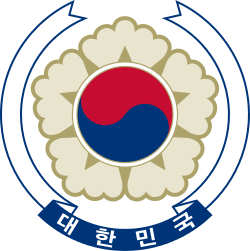
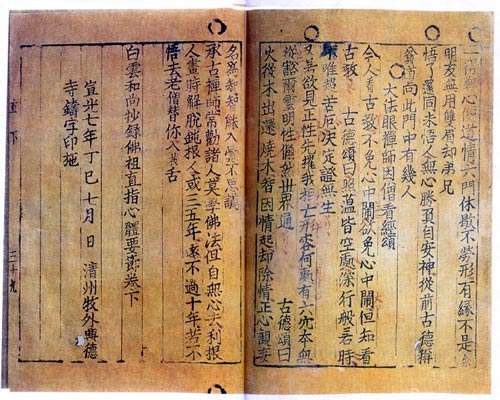
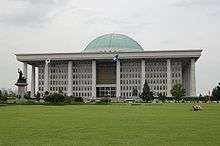
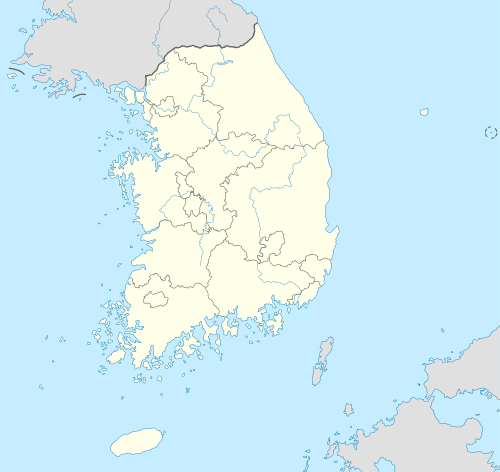
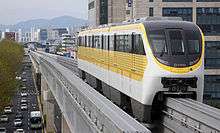
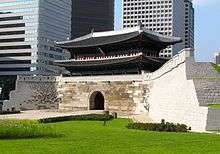
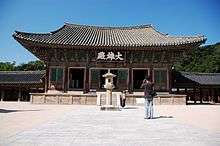
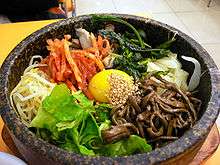
.svg.png)
